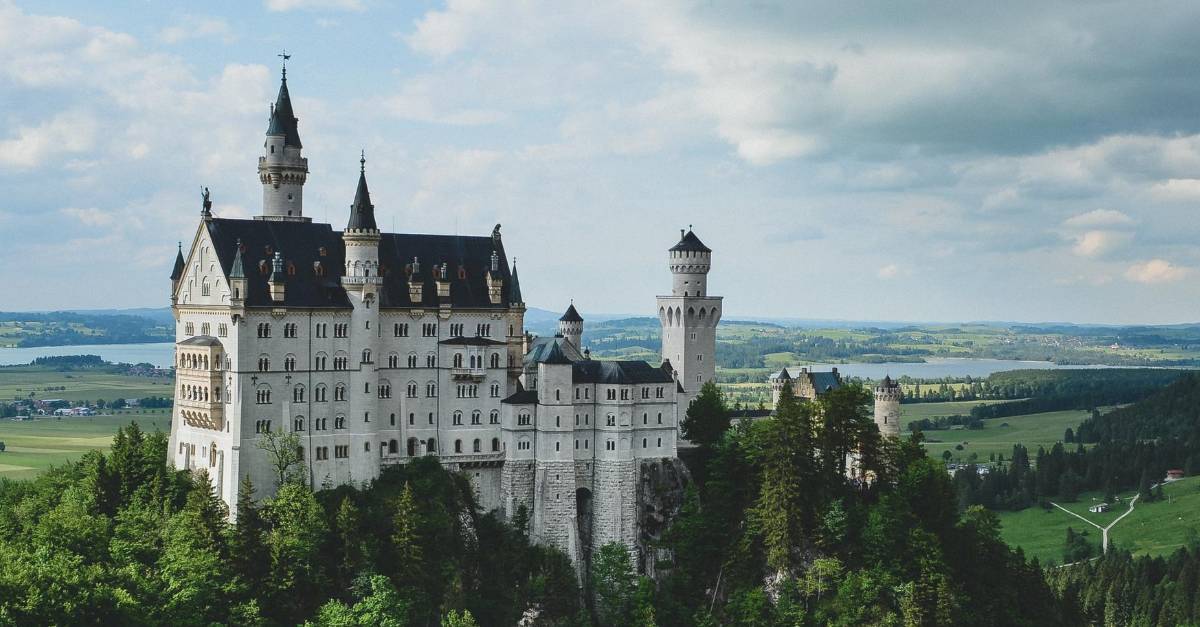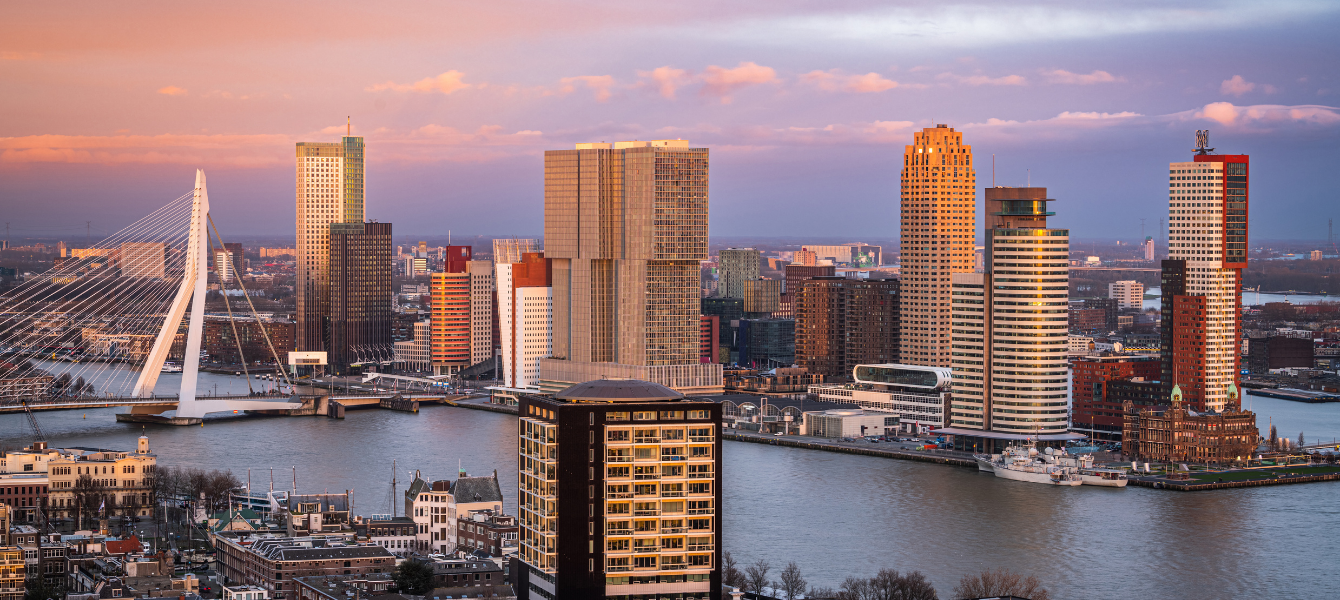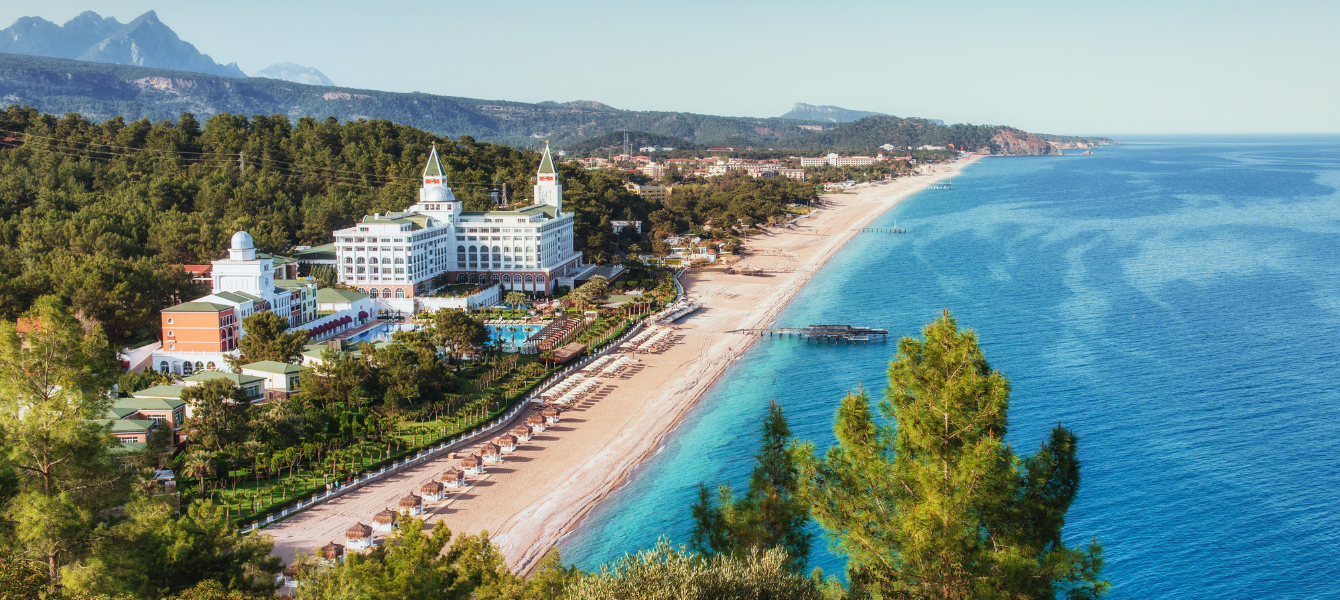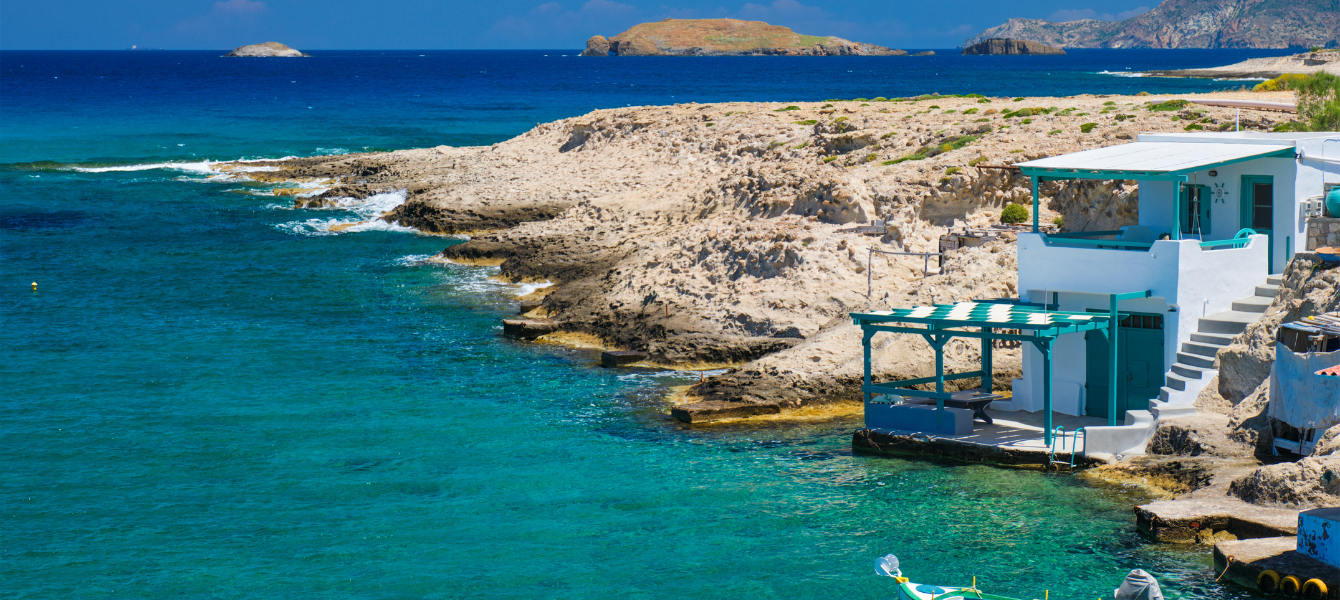Europe offers some of the most incredible history and rich culture in the entire world. For visitors coming to Germany, France, the UK, and more to experience Europe’s many wonders, there is one way to ensure a historical and magical experience, unlike any other.
By visiting the best and biggest castles in Europe. From 18th-century fortresses to 13th-century palaces to old castles from as early as the 1st century, there is so much to discover.
From learning about the history of the royal families, battles, and wars fought over regions and territories throughout the continent, and the relationships to these castles through bloodlines lasting for generations, visitors will be swept away off their feet at each of these monumental sites.
Millions of people travel the globe just to perfect pictures of beautiful castles to create their own fairytales. But before diving into the most remarkable castles in Europe, take a moment to learn why castles were and remain so important to European life.
The Importance of Castles in Europe
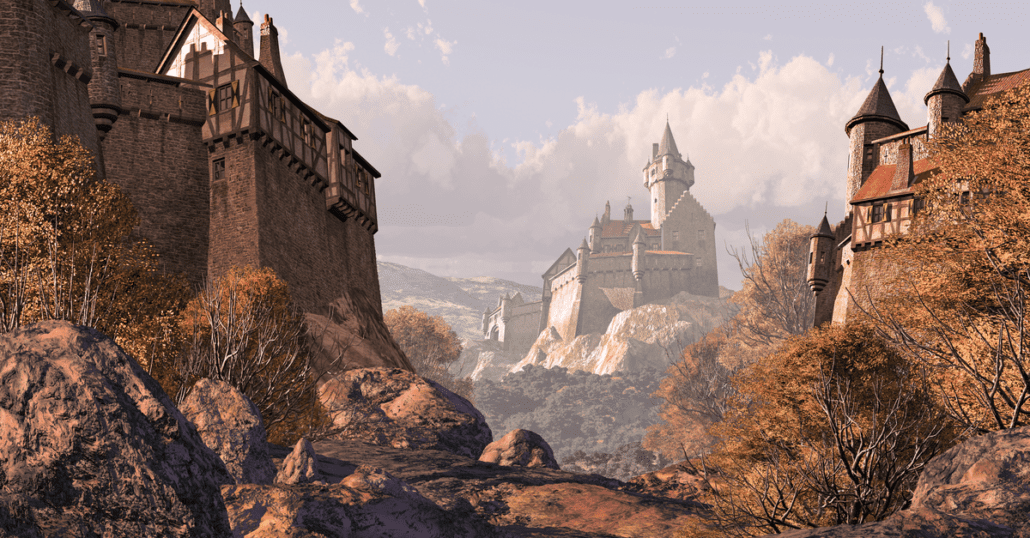
In medieval times, castles in Europe served many great purposes including protecting the nobility. Here are some fun and interesting facts about these magical castles you may not know.
- Most castles in Europe were built in the Middle Ages. There are more than 10,000 medieval castles and their remains in Europe.
- Not only did they protect nobility, but they also served as political centers, local government offices,
- The European country with the most castles, is Germany, with over 25,000. Some of the oldest including Meerburg Castle and Wartburg Castle still remain intact.
- Moving into the Renaissance era, many of these historical monuments became military fortresses.
- Windsor Castle is the oldest castle in Europe to still be inhabited. But more on that later.
40 Castles to Visit in Europe
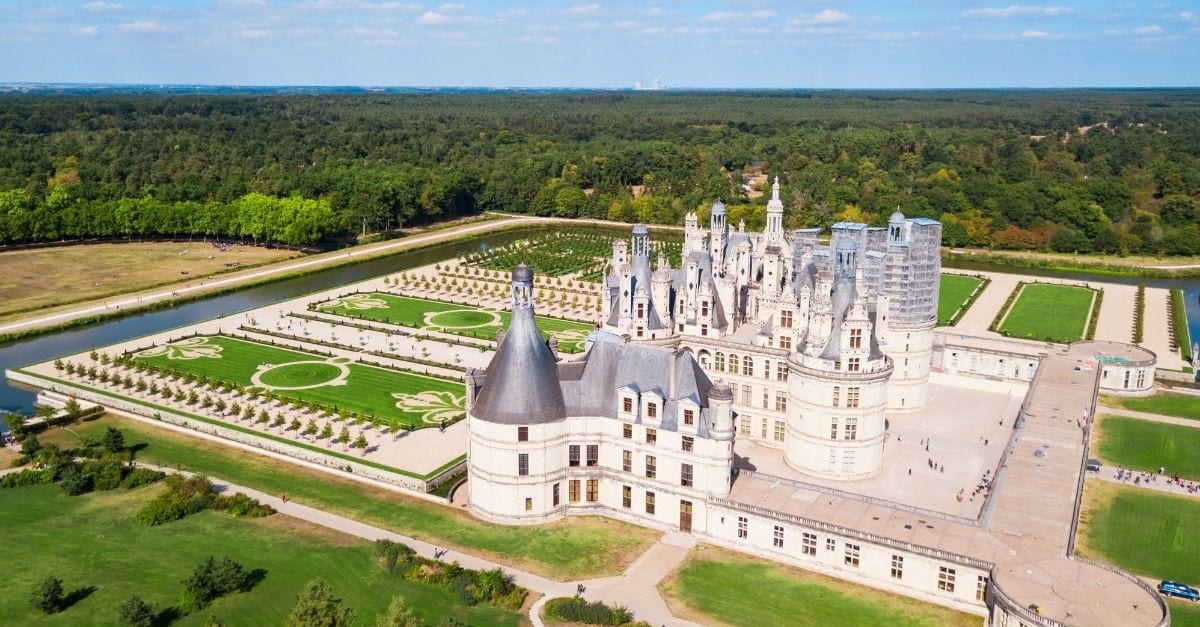
With thousands of castles to choose from it’s hard to pick just 40. These European castles stand out for their beauty, history, fortitude, and international popularity. If exploring Europe’s most impressive castles is on your bucket list this year, then this list is the perfect place to start. Spoiler alert: there are 16th-century fortifications, Gothic-style castles, World Heritage Sites, and more.
Castles in Germany
Neuschwanstein Castle, Bavaria
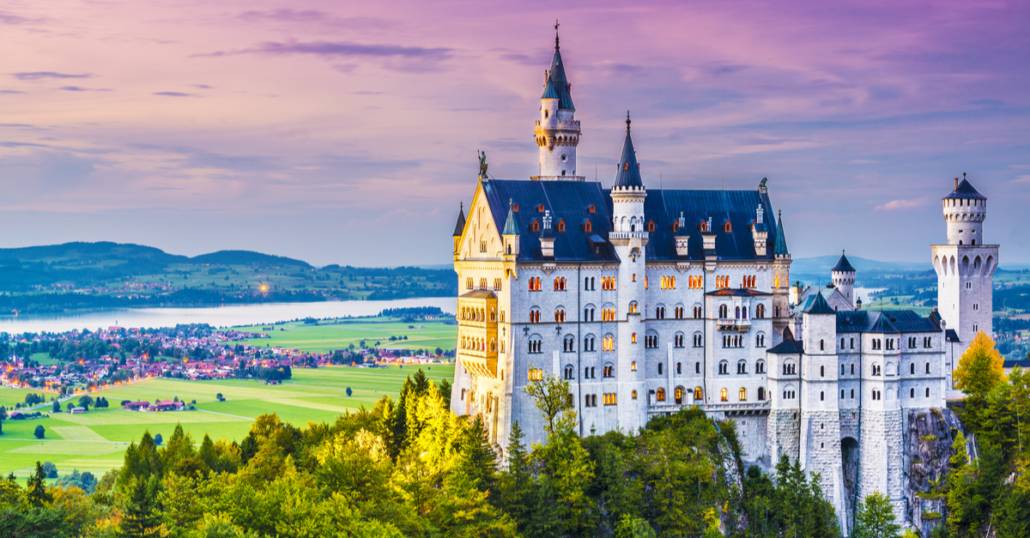
Arguably the most popular castle in the world is Neuschwanstein Castle in Bavaria. With over 1.4 million visitors a year, this 19th-century Romanesque palace is the perfect image of beauty and power.
The fortress was commissioned by King Ludwig II, so he could retreat from public life. It remained his home until he died in 1886, and it was then open to the public since then. It is nicknamed “the castle of the fairy-tale king,” for its magical details, design, and splendor.
The Neuschwanstein Castle, Germany, is also rumored to be the inspiration behind the castle in Disney’s Cinderella, and also has a shocking resemblance to Sleeping Beauty’s Castle.
For a truly breathtaking sight, visitors should visit the castle during the fall when the colorful autumn foliage surrounds the castle. Visiting this site really is like walking into a fairytale.
Wartburg Castle, Eisenach
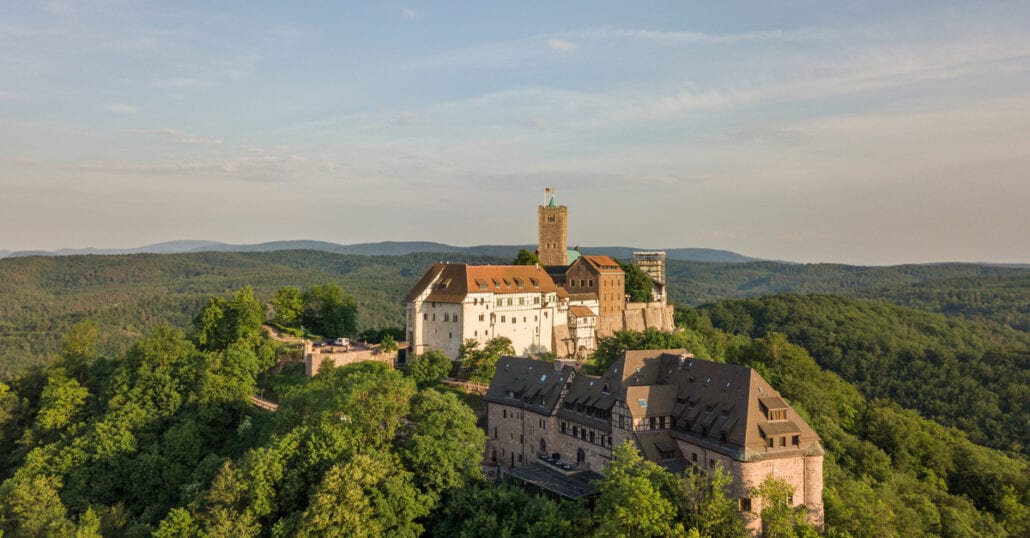
The first German castle to be listed as a UNESCO World Heritage site, the Wartburg Castle is the second most-visited tourist attraction in Thuringia, after Weimar.
Overlooking the town of Eisenach, the castle was home to St. Elisabeth of Hungary and also the place where Martin Luther translated the New Testament into German.
Built in the Middle Ages, Wartburg is one of the finest castles in Europe and provides its visitors with a rich overview of the history of Germany.
And even though the fortress was built in the 12th century, its interiors date back to the 19th century, when they were renovated.
One of the highlights of the palace is its art collection, which includes paintings by Lucas Cranach, tapestries, sculptures, Renaissance works of art, and furniture.
Heidelberg Palace, Heidelberg
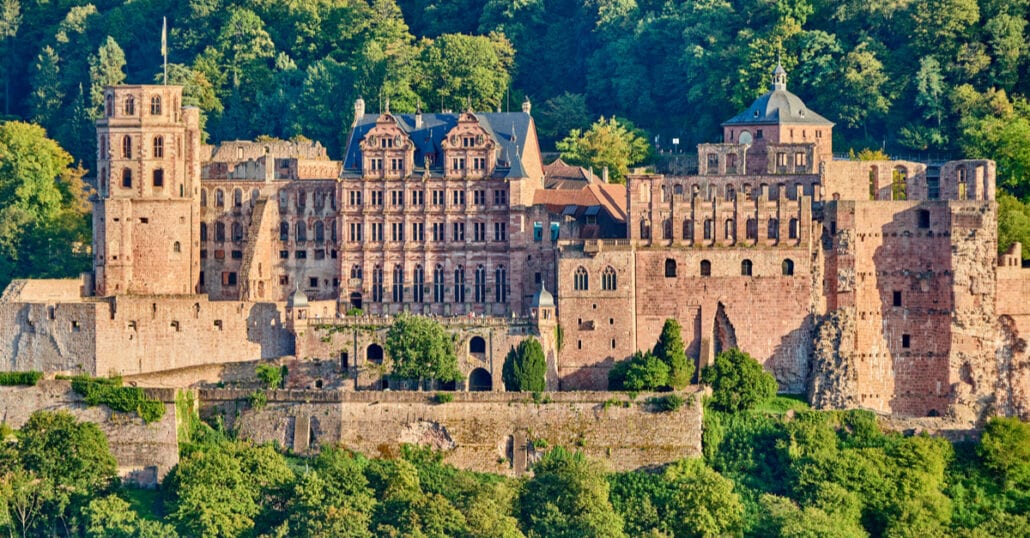
The Heidelberg Palace is considered one of the most important Renaissance buildings north of the Alps. Located 300 feet above the city of Heidelberg, in Germany, the castle was built around 1300 and it used to be the residence of the Wittelsbach dynasty.
In the late 17th century, the palace was attacked and then destroyed by the French during the War of the Grand Alliance. Since then, it has been partially rebuilt and it consists of a combination of buildings surrounding an inner courtyard, each one of them highlighting specific periods of German architecture.
One of the most stunning parts of Heidelberg is the Great Terrace and the gardens, with views of the Neckar Valley.
Hohenzollern Castle, Mount Hohenzollern
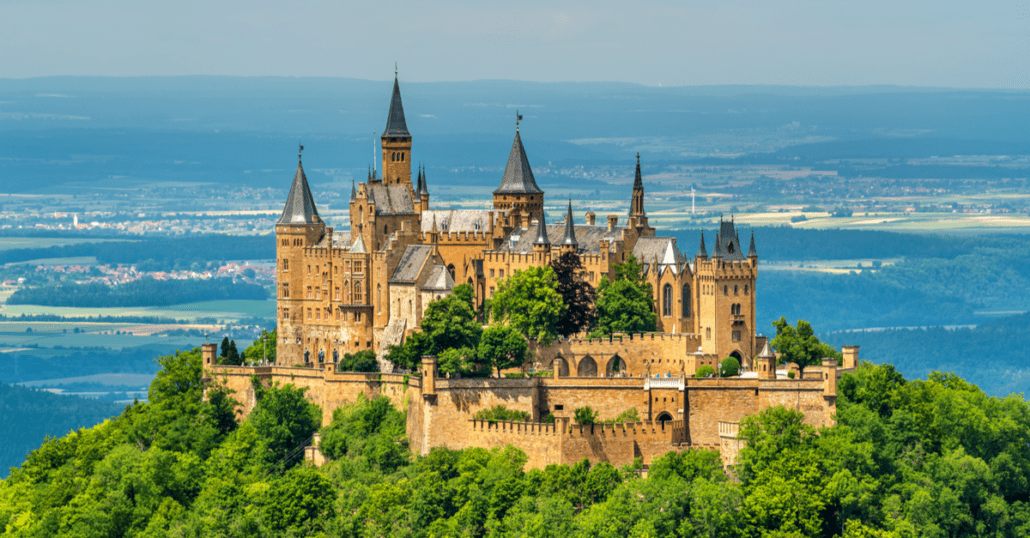
The Baden-Württemberg in southwest Germany is home to one of the most beautiful castles, Hohenzollern.
Construction on the current castle began in 1850 after the two castles that were previously in the same location were destroyed.
The original Hohenzollern castle dates back to the 11th century and a second from the 15th century.
The castle sits atop Mount Hohenzollern and is straight out of a fairytale overlooking the whole region.
On a clear day, visitors can see as far as 60 miles (100 kilometers) away. The Hohenzollern Castle includes military architecture, palatial buildings, gardens, and chapels.
Best Castles in France
Château de Chambord, Chambord
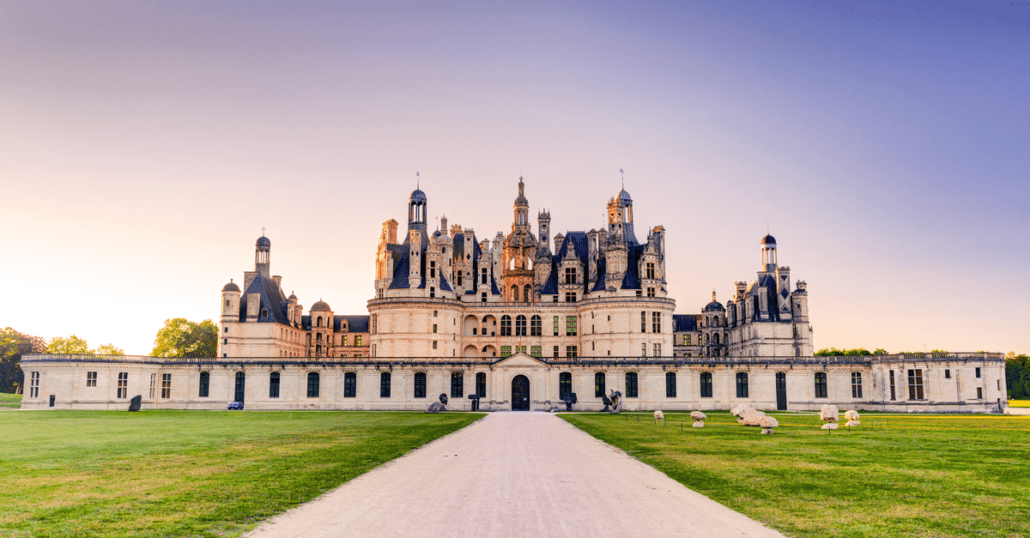
Known for being the largest château in the Loire Valley, the Château de Chambord, France, lives up to its impressive reputation. Its impressive and distinctive French Renaissance architecture makes it one of the most recognized châteaus in Europe.
Although constructed under the reign of Francois I in 1519, the building was not completed until the reign of Louis XIV.
With influences from Leonardo da Vinci and Domenico da Cortana, the medieval and classical styles of architecture were blended together to make one of the most beautiful structures in 16th-century Europe.
The Château de Chambord is currently open to the public and welcomes millions of visitors a year. It is also notably one of the only castle structures to have survived from that age without major modifications to its original design.
Château du Haut-Kœnigsbourg, Orschwiller
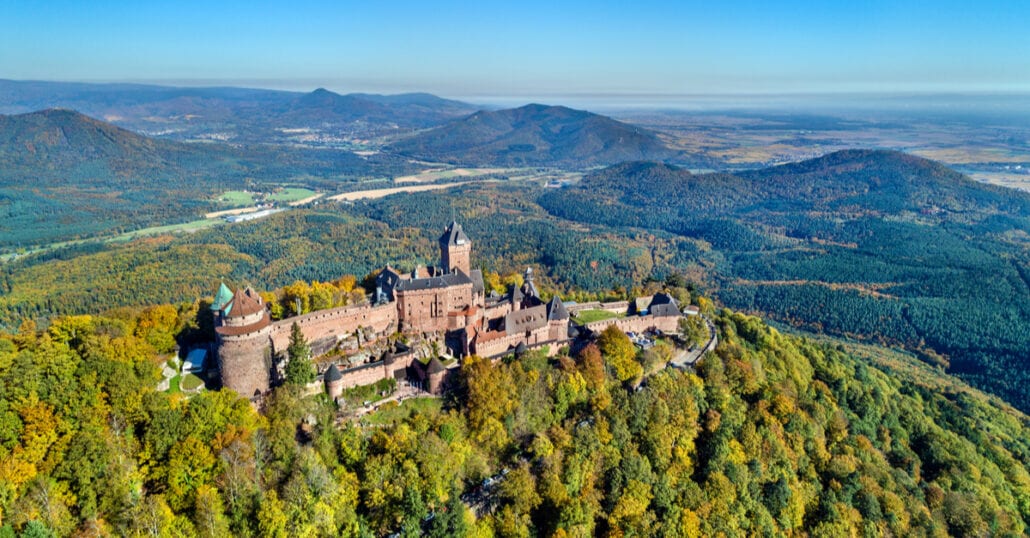
Placed in the commune of Orschwiller in the Bas-Rhin départment, The Château du Haut-Kœnigsbourg is the only medieval castle in Alsace that has been fully restored.
This sumptuous castle stands on a rocky outcrop nearly 800 meters high in the Vosges mountains, overlooking the Upper Rhine Plain.
Built by the Hohenstaufens in the 12th century, the Haut-Kœnigsbourg castle was used from the Middle Ages until the Thirty Years’ War, and, from 1900 to 1908, it was rebuilt at the behest of the German Kaiser Wilhelm II.
With a decorated hall filled with ornamental frescoes and a medieval garden home to aromatic and medicinal plants and vegetables, the castle attracts more than 500,000 visitors a year.
Curious fact: in 1937 the Château du Haut-Kœnigsbourg was used as a location for the movie “La Grande Illusion”, by the French film director Jean Renoir.
Château Gaillard, Normandy
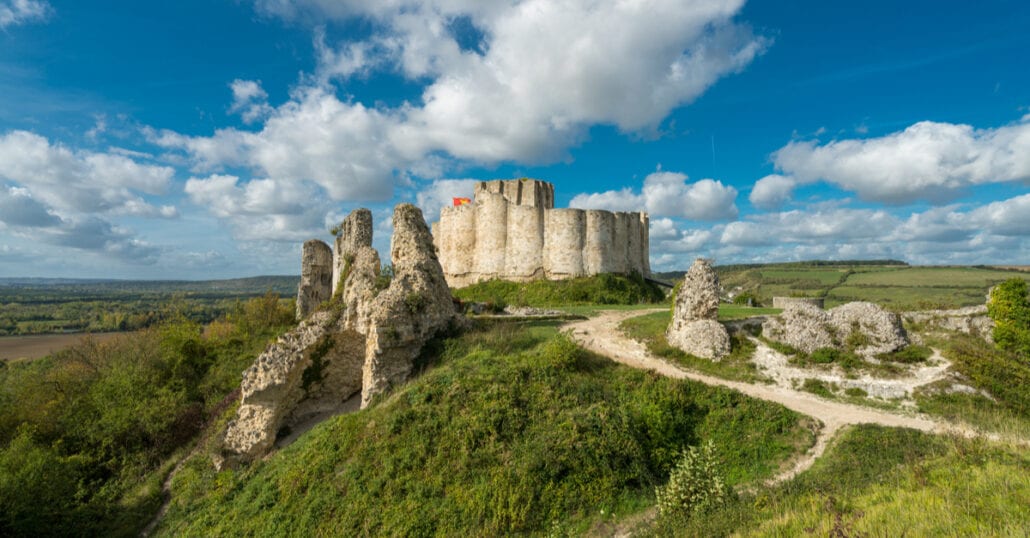
The Château Gaillard offers one of the most memorable views of the Seine. Perched on the Andeleys Cliff, high above the River, the castle was built under the auspices of the King Richard the Lionheart, in 1196, and it was used to guard the Seine River Valley.
Even though its construction took only two years, the castle was skilfully designed, consisting of a pentagonal outer bailey with 5 towers. Nowadays, the Château Gaillard it’s a ruin with remains of the salient tower and a slightly melancholic atmosphere topped by Normandy’s scenario.
Château D’Angers, Maine-et-Loire
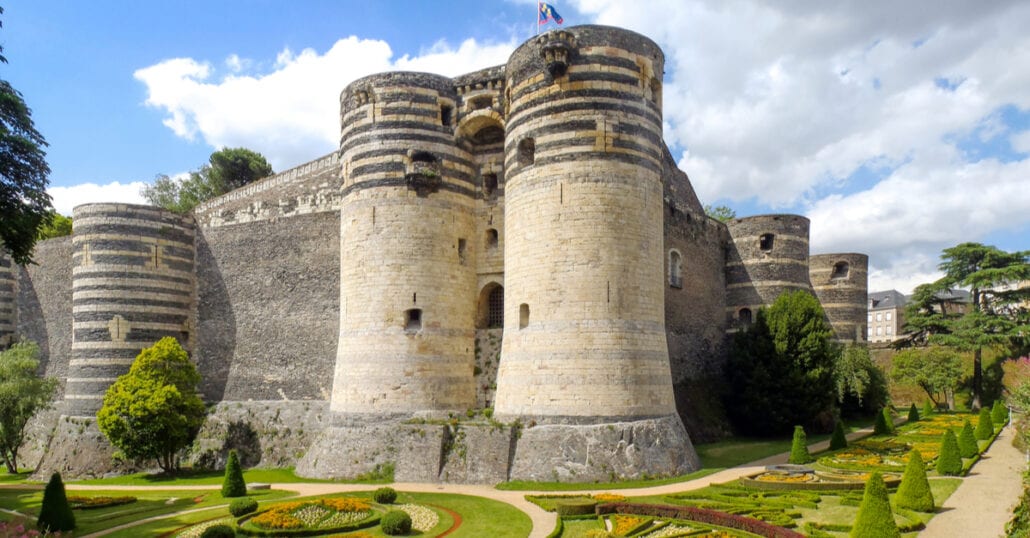
The Château D’Angers is a citadel with 17 limestone towers and medieval fortifications that stretches almost 500 meters.
Built in 1230 to dissuade potential attackers in the city of Angers, in the Loire Valley, the castle stands on the top of a rocky outcrop overlooking the River Maine.
What’s most impressive about the Castle is that it houses a tapestry, which is nowadays considered a major work of medieval art.
The Tapestry of the Apocalypse was commissioned by the Duke of Anjou – who occupied the fortress in the 14th century- and it illustrates the story of the Apocalypse from the Book of Revelation, by Saint John.
This masterpiece is currently displayed in a special gallery in the fortress. The castle is also home to ducal buildings, a large garden with a vineyard, and a rose garden.
Château de Coucy, Picardy
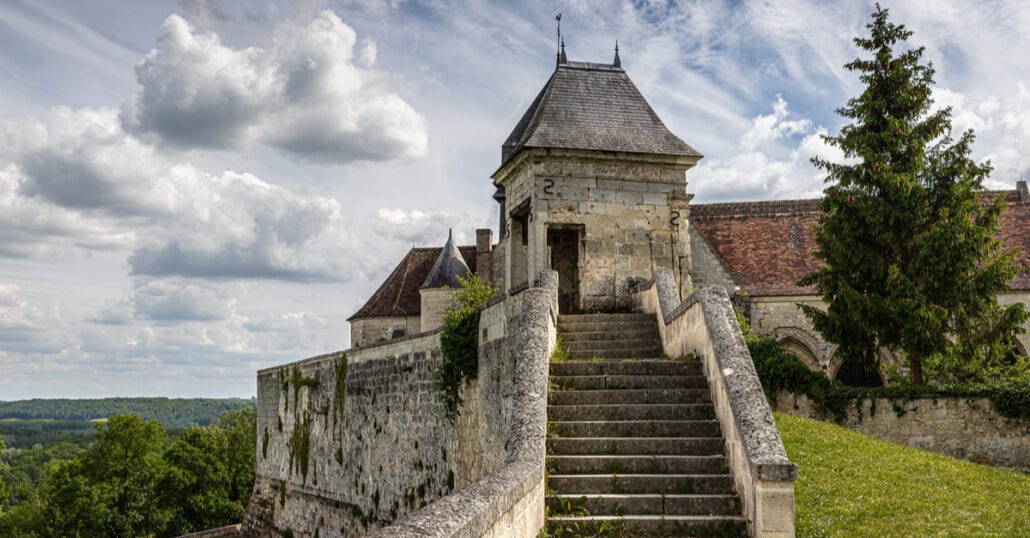
Constructed in the 13th century by Enguerrand III, the Lord of Coucy, the Château de Coucy, is located in the commune of Coucy-le-Château-Auffrique, which used to be a fortified town in Picardy, Northern France, in the Middle Ages.
Later in the 19th-century, the château was renovated by Eugène Viollet-le-Duc in the 19th century and transformed it into a palace.
But in April 1917 part of the castle was destroyed by the German army. But despite that, a visit to the Castle of Coucy is still worth it.
With views of the Oise and Ailette valleys, the construction features a monumental fireplace with sculptures of the Nine Preuses (female Worthies). In July, they host “Coucy à la Merveille”, a medieval sound and light show, performed within the castle walls.
Château de Gisors, Gisors
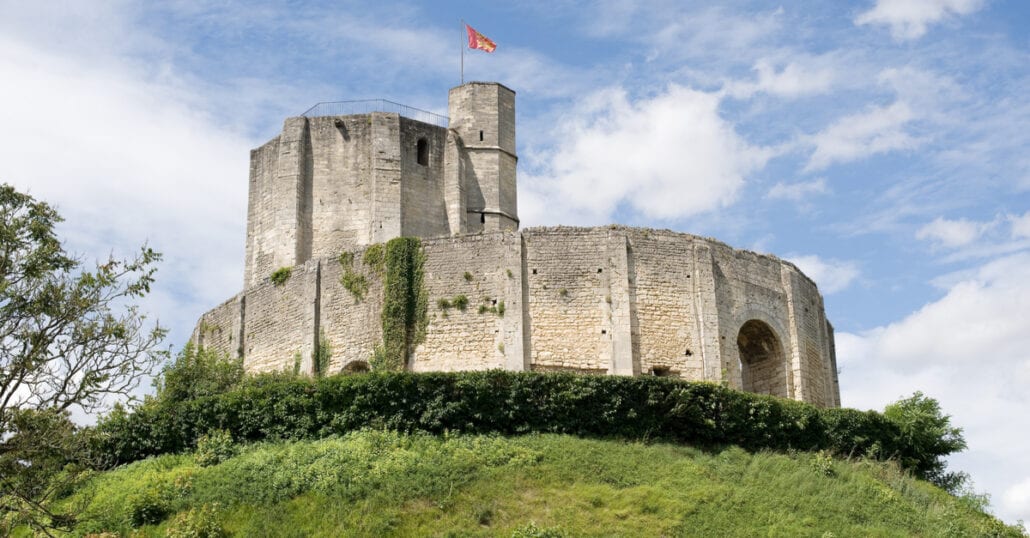
The Château de Gisors might have witnessed some of the most important meetings in history. In 1113, the castle hosted a meeting between Henry I of England and Louis VI of France.
Later on, in 1158, Henry II of England and Louis VII of France met at the Gisors Castle. In 1118 another royal meeting, this time between Henry II of England and Philip II of France took place in the castle.
So if you’re eager to uncover a palace filled with history, the Château de Gisors is the place. Built by Robert of Bellême, 3rd Earl of Shrewsbury, on the order of William II of England, the Château de Gisors was a fortress of the Dukes of Normandy in the 11th and 12th centuries.
But there’s more to it. Recognized as a French Monument Historique, the Château de Gisors was transformed into a prison in the 14th century, and during the Trials of the Knights Templar in the early 14th century, it held imprisoned Templar knights.
Nowadays the Château de Gisors in the medieval town of Gisors is famous for its public garden with views of the Epte Valley.
Château des Baux, Les Baux-de-Provence
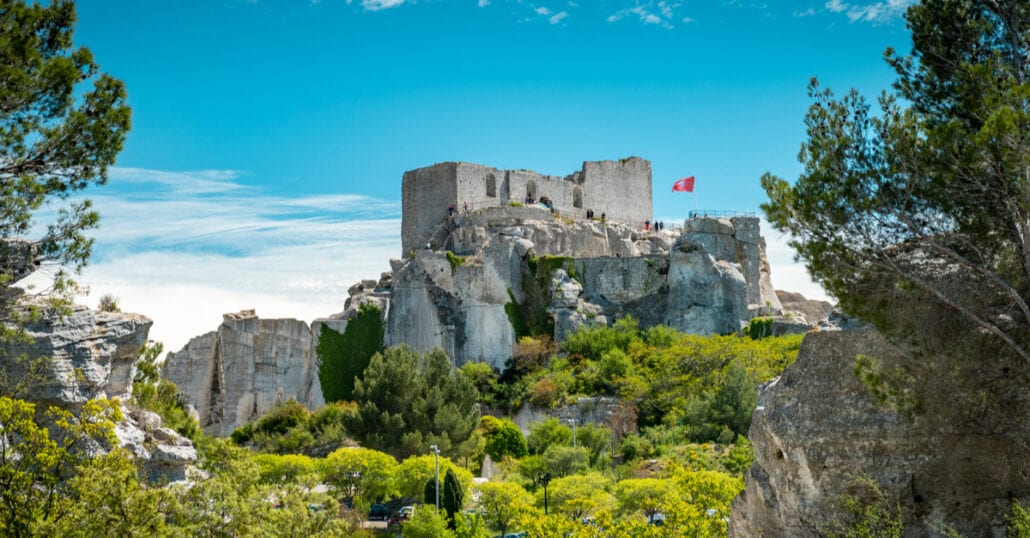
The charming Provence, in southern France, has more than vineyards, olive groves, and lavender fields. The region is also home to a designated Historic Monument and one of the most magnificent castles in the country: the Château des Baux.
Built in the 10th century over 7 acres of the Alpilles range, the castle sits within a site that has been continuously inhabited from prehistory to the present day.
The fortress was ruled by the lords of Baux, one of the most affluent families of lower Provence during the Middle Ages.
Visitors can wander through the ruins and vestiges of this 11th-century fortress, the Saracen Tower, troglodytic houses, and a cistern, and see full-scale replicas of siege engines. A great idea is to take a self-guided audio tour to learn more about the history of the castle.
Château de Foix, Foix
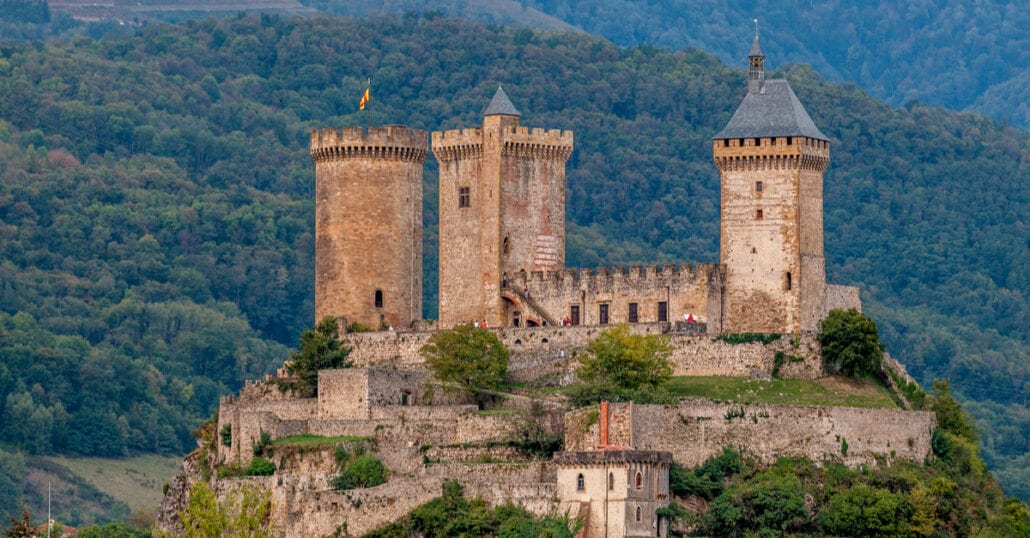
When traveling to the French Pyrenees, make sure to visit the town of Foix, in Ariége. Placed in the foothills of the Pyrenees, the commune is home to the tripe-towered Château de Foix, which history dates back to the 10th century.
Now a historical monument of France, the castle was home to persecuted Cathars, and a family of counts who became the viscount of Béarn and lately the Kings of Navarre and of France.
During the 12th and 13th centuries, the castle was much smaller, having only 2 square towers. The third one was added in the 15th century and, nowadays, the monument houses a museum where you can learn about the history of the edifice.
Château de Chenonceau, Chenonceaux
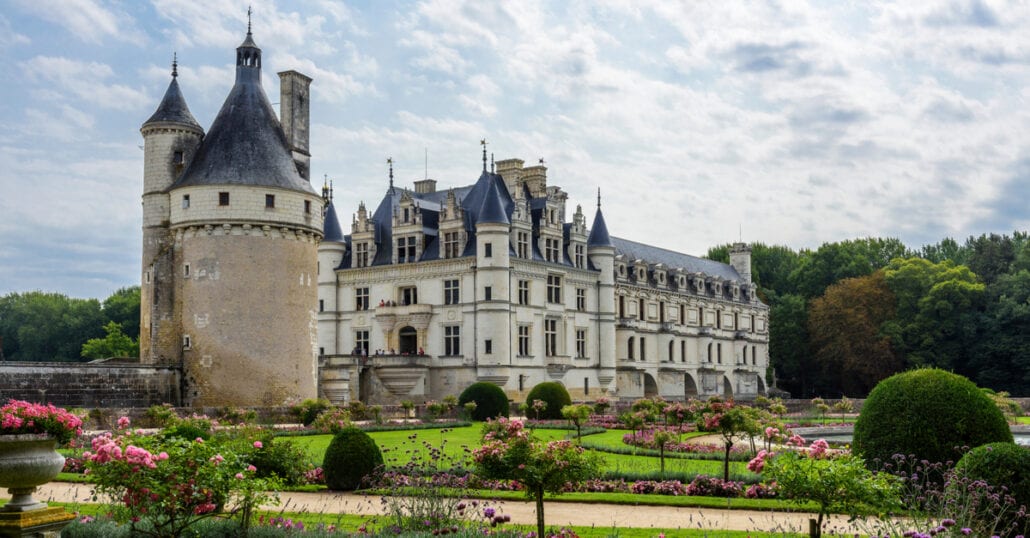
The Château de Chenonceau is one of the most popular castles of the Loire Valley. Erected in 1514–1522 by Thomas Bohier and above all his wife, Catherine Briçonnet, it’s a Renaissance masterpiece home to an outstanding collection of furniture, sumptuously furnished rooms, and tapestries.
The Château de Chenonceau also houses paintings by some of the greatest European painters of the 16th, 17th, and 18th centuries, including Tintoretto, Corregio, Veronese, Poussin, Van Dyck, Bassano, and Zurbaran just to name a few.
Castles in Spain
Alcázar of Segovia, Segovia
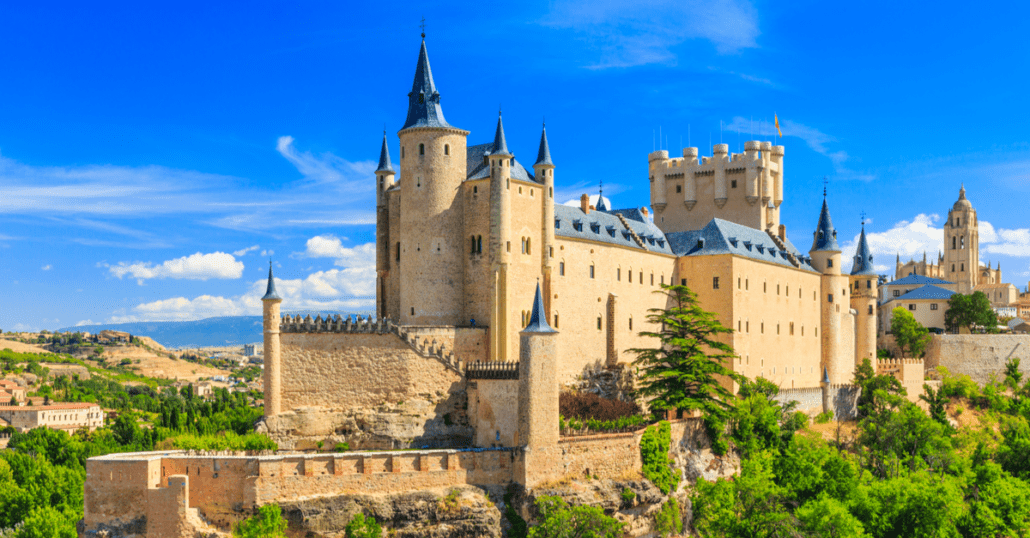
Located in the old city of Segovia, Spain the 12th-century Alcázar of Segovia or Segovia Castle is one of the most jaw-dropping castles in Europe.
With a mountain backdrop and its rocky location above the rivers, it is one of the most well-constructed and preserved fortresses in Spain. It even has a shape similar to that of a bow on a ship.
Although the Alcázar of Segovia was originally built as a fortress it has served many purposes since then including, a royal palace, state prison, and military academy, and is now open to the public to explore.
The Álcazar of Segovia, Spain, was also one of the inspirations for Walt Disney’s Cinderella Castle, similar to the Neuschwanstein Castle.
Best Castles in England
Windsor Castle, Berkshire
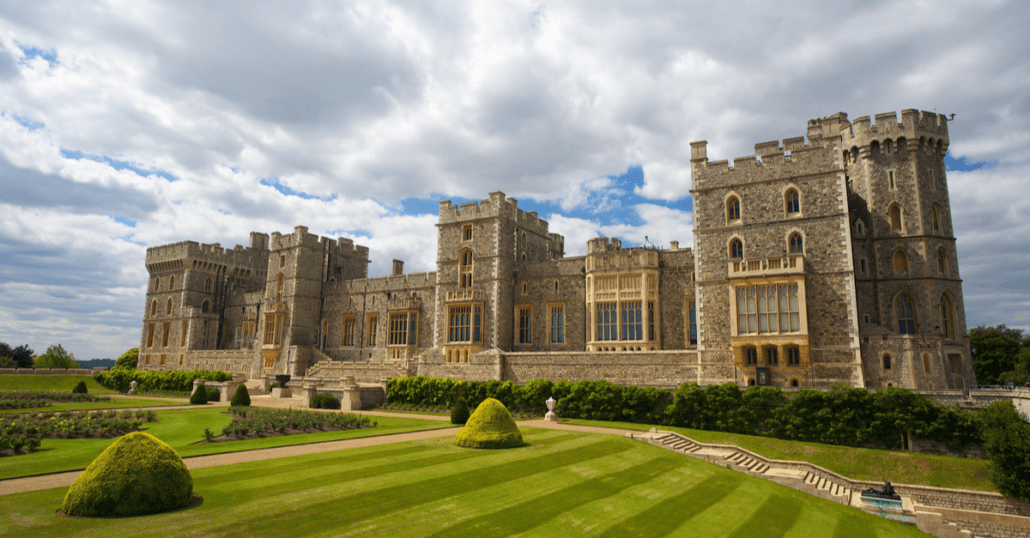
One of the most famous castles is without a doubt, Windsor Castle in Berkshire, England. With over 1000 years of architectural history, this castle has served the British royal family and monarchs as home since Henry I. It is the longest-occupied palace in Europe. It is the official residence of the Queen of England and is located about an hour away from central London. Fun fact, ten kings are buried at Windsor Castle, including Henry VIII.
Leeds Castle, Kent
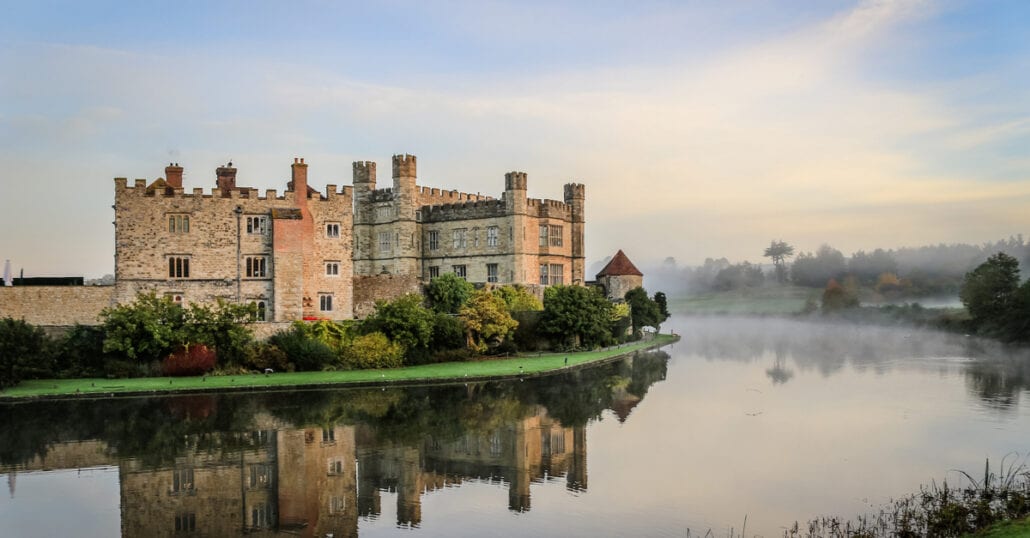
One of the best-preserved castles in South East England, the Leeds Castle has been a Norman stronghold; the property of six of England’s medieval queens; a country house; the residence of King Henry VIII, and even a 20th-century countryside retreat for affluent families in England.
Now, it’s a historic building open to the public, and set in over 500 acres of extensive parkland. Visitors can even stay overnight in the bed and breakfast accommodation, which is set in the refurbished Stable Courtyard Bedrooms.
A great tip for travelers staying at Leeds Castle is to explore the local Maze with 2,400 yew trees and stroll around the Princess Alexandra Gardens, perfectly placed alongside the River Len.
Warwick Castle, Warwickshire
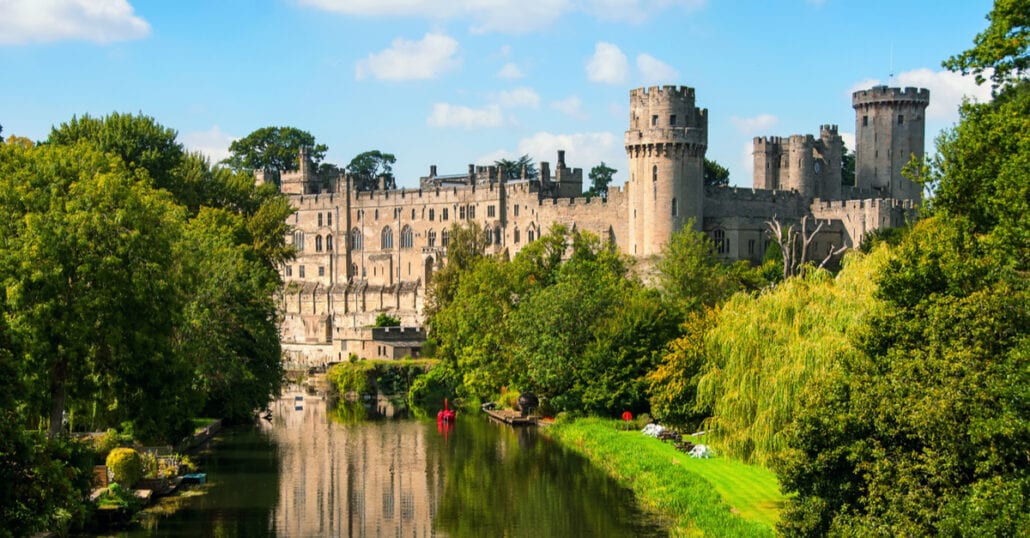
Originally built by William the Conqueror in 1068, the Warwick Castle was used as a stronghold until the 17th century when it was converted into a country house by Sir Fulke Greville.
During that time, the gardens’ development became a priority, and they were re-landscaped by one of Britain’s greatest gardeners, Lancelot “Capability” Brown.
Spread within 64 acres, the Warwick Castle is home to a Great Hall of approximately 12 meters high, 19 meters long, and 14 meters wide, being the largest room in the castle.
The palace also houses a State Dining Room, which has witnessed some of the most sumptuous dinner parties in history, with guests such as Queen Victoria and Prince Albert, and Queen Elizabeth II and Prince Philip.
Bodiam Castle, East Sussex
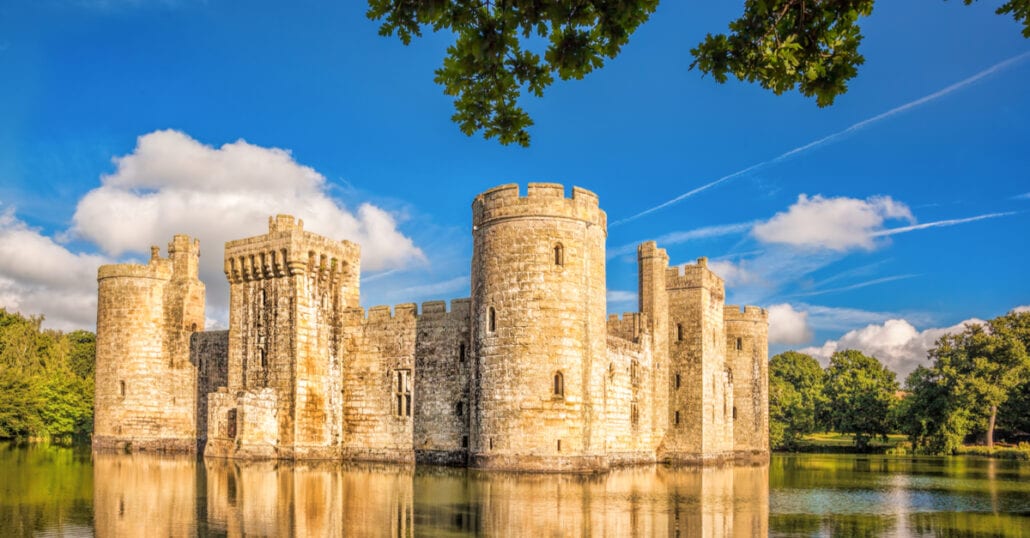
The Bodiam Castle was built in 1835 by Sir Edward Dallingridge and his wife Elizabeth, to defend the area against the French invasion during the Hundred Years’ War.
Over the decades, the property was repaired by a series of owners and it has been owned by The National Trust since 1925.
With a ruined interior, this 14th-century moated castle consists of a Coats of Arms, a Barbican, a Gatehouse with massively thick walls, a Chapel, a Postern Tower, once used for delivering goods, a Kitchen with a huge roasting hearth, and more.
Alnwick Castle, Northumberland
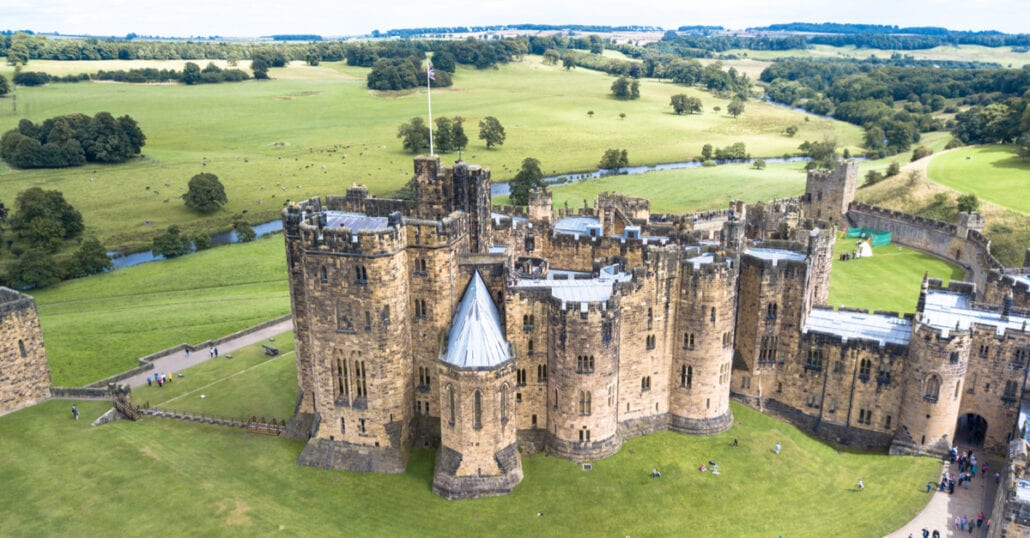
In 1309, the Alnwick Castle was still a Normal-style castle, until it was purchased by Henry Percy who converted the construction into a fortress.
Percy and his son spent 40 years adding towers to the castle, building a strong gatehouse, and adding stone figures to the tops of the battlements, just to name a few improvements.
Situated in Alnwick, in the county of Northumberland, the castle was remodeled several times and it evolved throughout 700 years of history.
Thanks to an extensive program of conservation, the castle displays unique medieval architecture, being home to staterooms, a courtyard, and even a picnic area.
Bamburgh Castle, Northumberland
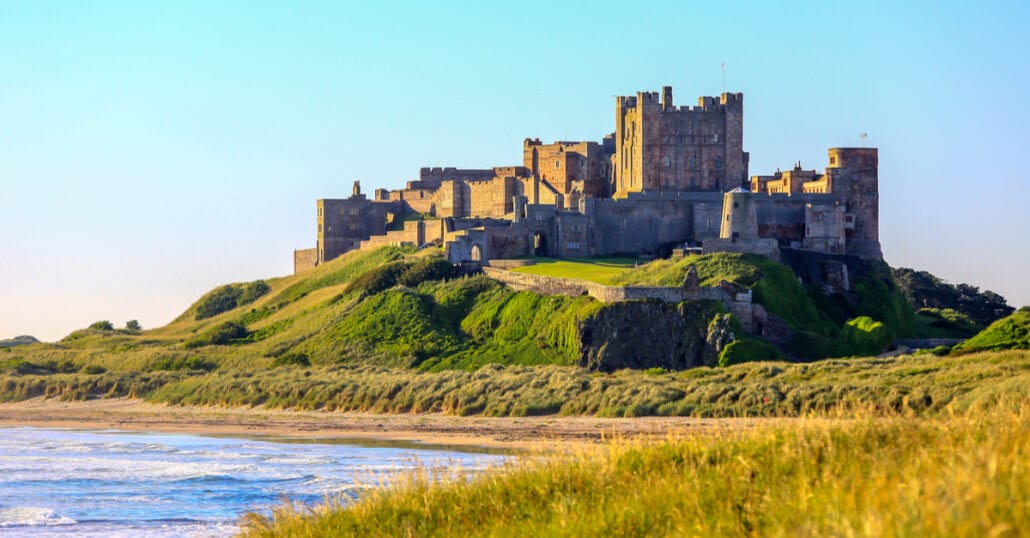
Bamburgh Castle was built on top of a volcanic rock, a 180-foot high basalt crag, which offers views of the surrounding countryside and the Northumberland coastline.
Occupied since prehistoric times, the location of the castle was also home to a Celtic Brittonic named Din Guarie.
Over the centuries, the construction became a mighty fortress, until it was purchased in the 19th century by Sir William Armstrong, who completely rebuilt and remodeled Bamburgh, transforming it into a Medieval castle.
Still owned by the Armstrong family, the property is open to the public and it boasts a collection of artwork, ceramics, and artifacts once owned by Sir. William.
Castles in Romania
Bran Castle, Transylvania
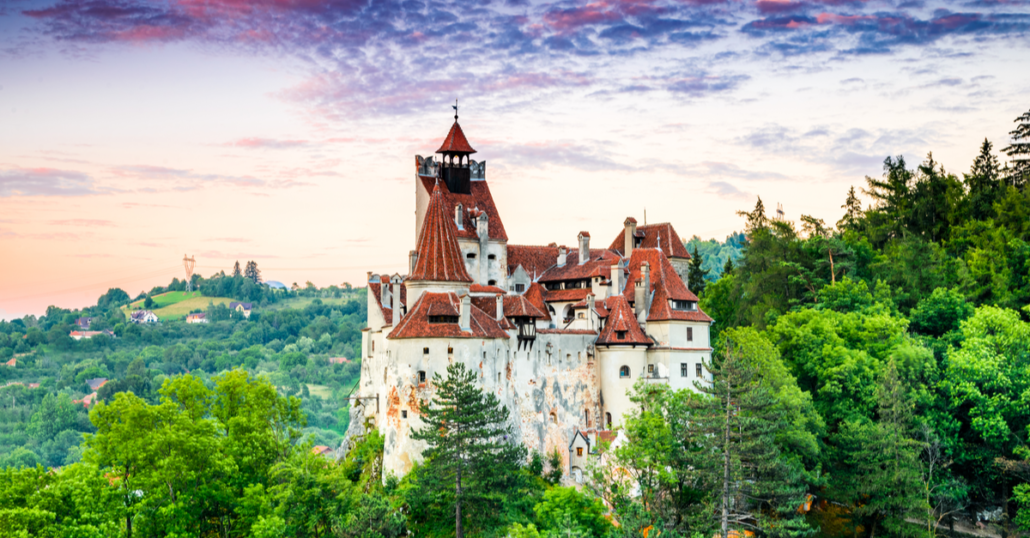
Located in Bran, Central Romania on the Transylvanian side, Bran Castle is home to one of the most historical legends.
Famous for its incredible stature and position, this castle is also commonly known as Dracula’s Castle, however, it is only one of the many locations connected to the legend.
It is also commonly mistaken as the home of the title character in the book, however, there is no evidence to support that author, Bran Stroker, knew anything about this castle before publishing the book.
Bran Castle, Romania, dates back to the 14th century and was intended to protect the region from the Ottoman Empire.
In 1920 the castle was refurbished to display furniture and art collected by Queen Marie and has been a museum open to the public since the late 1800s.
When visiting Bran Castle, you can also explore the traditional Romanian cottages, barns, and architecture at the bottom of the castle’s hill.
Corvin Castle, Hunedoara
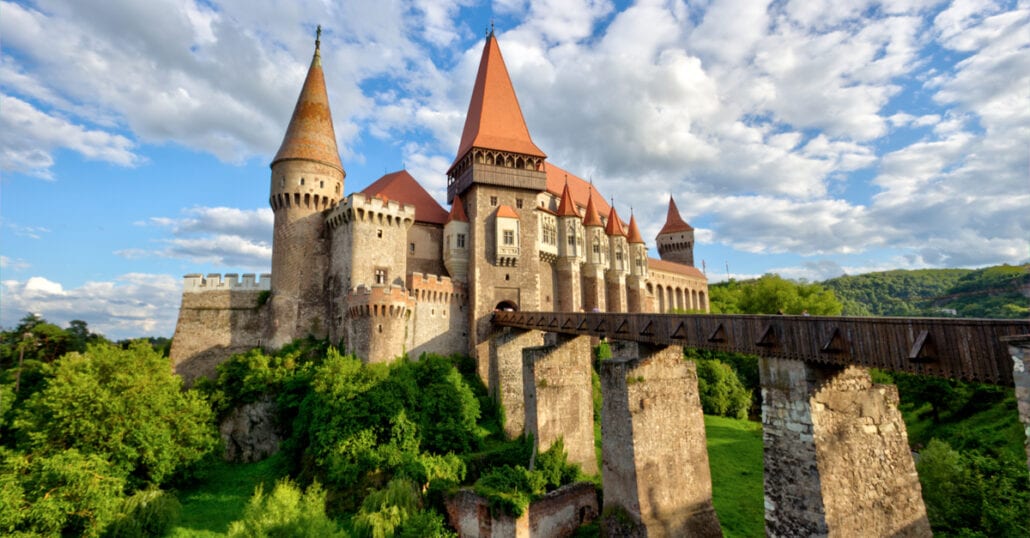
Aside from the Bran Castle, make sure to also include a visit to the Corvin Castle on your Romania bucket list. This beautiful gothic-style castle is one of the largest castles in Europe and a major tourist attraction in Transylvania.
Also known as Hunyadi Castle or Hunedoara Castle, the construction was built by the Anjou family and it served as a fortress until the mid-14th century.
Thanks to several restorations, this castle in Romania still houses preserved features, like a majestic Knights’ Hall, a courtyard, a chapel, and 50 rooms filled with medieval art.
Castles in Lithuania
Trakai Island Castle, Trakai Island
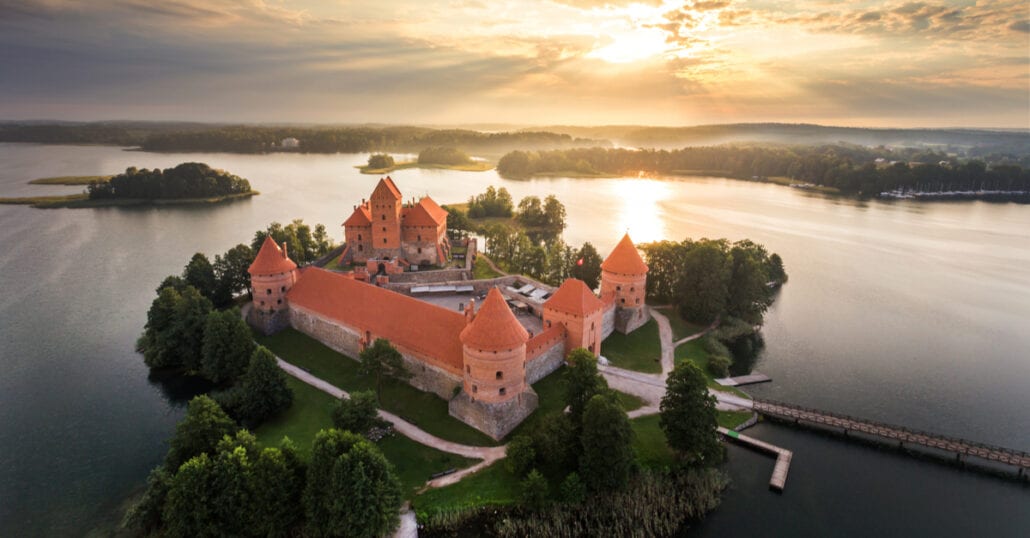
Home to all the Grand Dukes of Lithuania, the Trakai Island Castle was built in the 14th and 15th centuries on one of the islands of Lake Galvė.
The castle had great strategic importance, as it was surrounded by water on all sides, and it was considered a true masterpiece of medieval defensive architecture. In fact, it was the only castle built on water in Eastern Europe.
Today the castle houses a museum, the Trakai History Museum, where you can find furniture, porcelain, glass, collections of coins, ancient maps, hunting trophies, and more.
Castles in Portugal
Pena Palace, Sintra
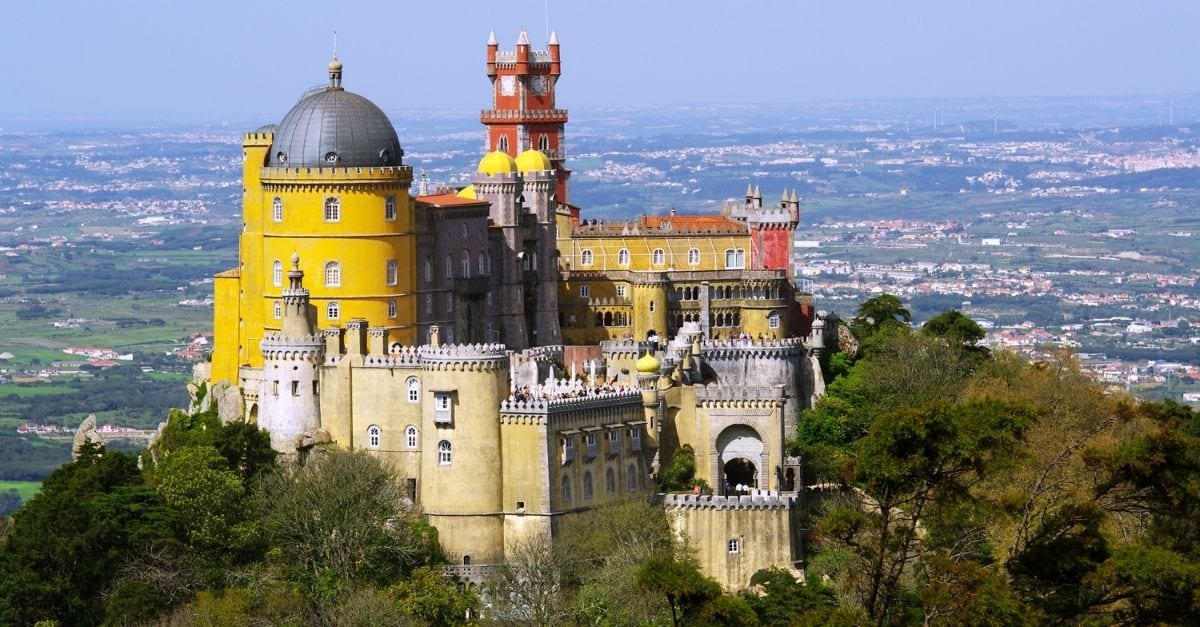
One of the most popular places to visit in southern Portugal is the incredible Pena Palace in Sintra. The town of Sintra on its own is famous for being a European country known for its historic sites, castles, and palaces, which are UNESCO World Heritage sites, but the Pena Palace stands out above the rest.
Quite, literally, as it is one of the highest structures on this list, often photographed above the clouds.
The Pena Palace, Portugal, was created and designed by King Ferdinand II and its architectural style reflects 19th-century romanticism.
The elaborate decor of the palace interior is just as colorful as its painted exterior, and the views from the top terraces are something everyone must experience at least once in their lifetime.
Castle of the Moors, Sintra
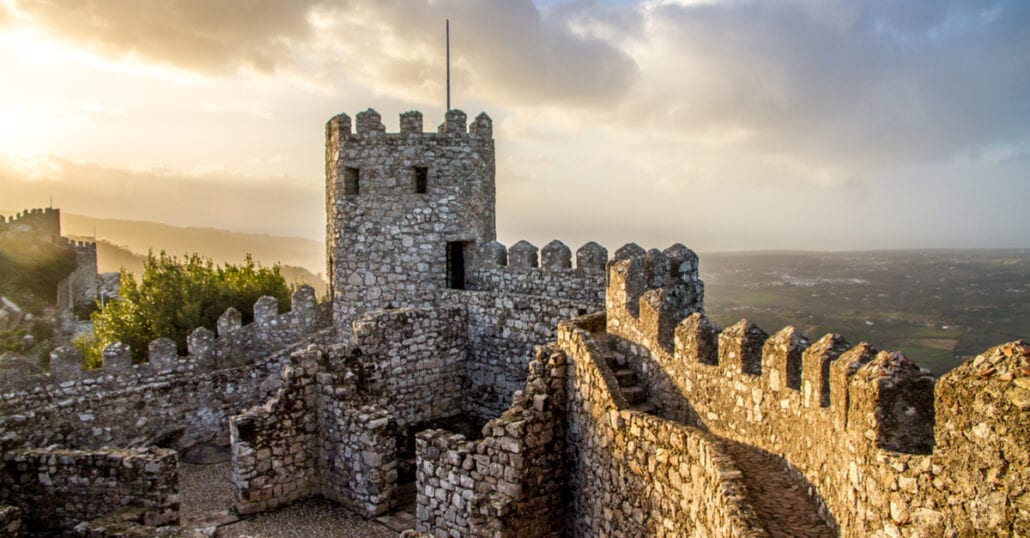
When visiting the charming city of Sintra, in Portugal make sure to add a visit to the Castle of the Moors to your itinerary.
Built on an isolated rocky outcrop, the castle defended the city during the Moorish era from the 8th to the 12th century, as it gave moors the advantage of having a strategic view along the coastline.
The fortification was taken by Christian forces in 1147 and in 1838 acquired by Ferdinand Saxe Coburg-Gotha, King Consort of Queen Maria II.
He restored the ruins, which remain one of the main attractions in Sintra. With an irregular plan, the Castle of the Moors offers a stunning overview of the hills of Sintra, the Pena Palace, and the ocean.
Castles in Poland
Moszna Castle, Moszna
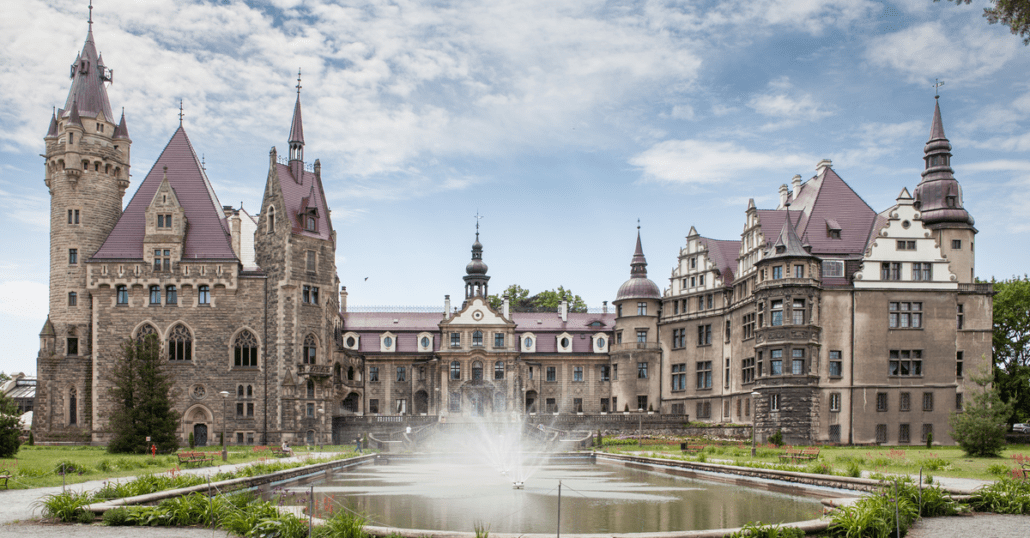
The 17th-century Polish landmark, Moszna Castle, is one of the most important monuments in Poland. This fairy-tale castle is the former residence of the German Tiele-Winckler family and has 365 rooms and 99 turrets.
While the castle is the focal point of the complex, the entire area includes fields, gardens, meadows, and its own forest.
Today the castle’s chapel is used as a concert hall, and the site also hosts serval works of art from many famous artists. The natural landscapes make for the perfect place to spend an afternoon.
Castles in Austria
Hohenwerfen Castle, Werfen
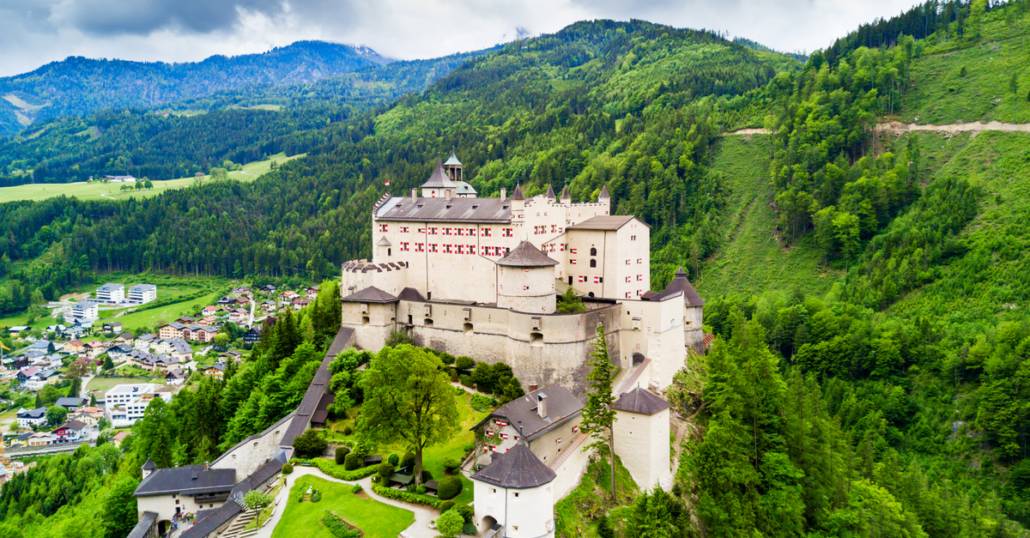
Surrounded by the gorgeous Berchtesgaden Alps, visitors can come and see the Hohenwerfen Castle near Salzburg, Austria. This medieval rock castle is situated on a 2,044 feet tall (623-meter) cliff. It looks over the town of Werfen and was originally built in the 11th century by the Archbishops of Salzburg.
Hohenwerfen also is a sister of the Hohensalzburg Fortress which was built by the same archbishops.
Serving as a home to royalty and the clergy, this castle was inhabited for 900 years. It also served as a state prison for a period of time during its inhabited period.
One of the castle’s must-see places? The falconry center, where visitors can see eagles, falcons, vultures, and other local birds of prey show off their skills and the historic art of falconry.
Castles in Scotland
Eilean Donan, Kyle of Lochalsh
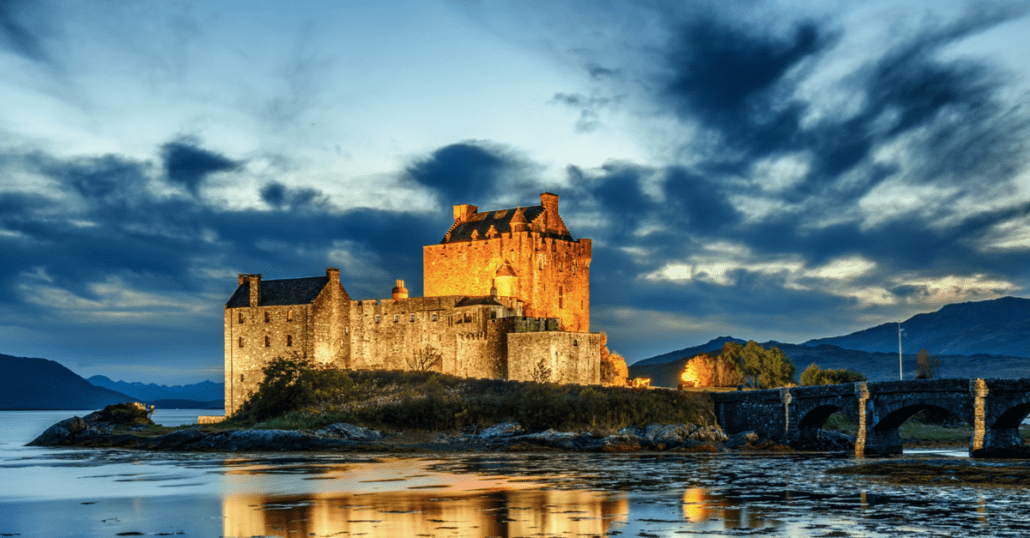
Scotland’s famous Highlands are home to one of the most famous castles in Europe, Eilean Donan. This 13th-century castle is located on an island where three great sea lochs meet, with an expansive mountain backdrop.
Over the course of history, Eilean Donan Castle, Scotland, has been built and rebuilt four times. The first and original castle was built during the Middle Ages to protect the lands of Kintail against the Vikings. Due to its location and size, it was the best place to protect Scotland from invaders.
Today, this is one of the only castles in the world where almost all parts of the castle can be explored and visited by the public.
Edinburgh Castle, Edinburgh
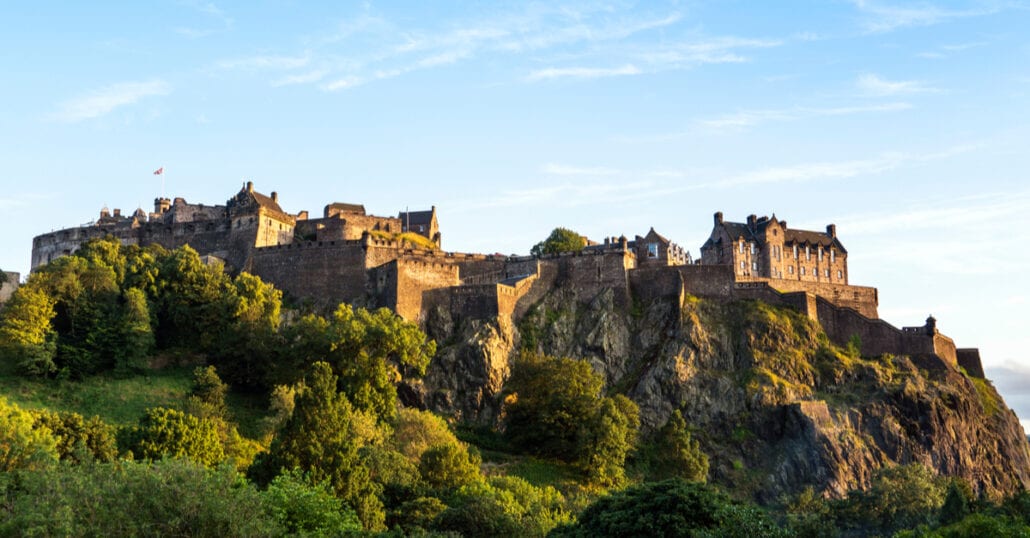
Edinburgh Castle, Scotland, is a historic fortress that changed hands many times during the centuries. It was home to kings and queens, such as Queen Margaret and King James IV, aside from hosting courtly balls and banquets.
The castle has undergone several restoration programs, and it currently offers a series of highlights to its visitors. In fact, there are many ways to experience a visit to Edinburgh Castle.
You can create your own itinerary, or take a guided tour. Be sure to visit the St Margaret’s Chapel, the castle’s oldest part, which dates from the 12th century; the Great Hall; the National Museum of Scotland, and more.
Dunnottar Castle, Stonehaven
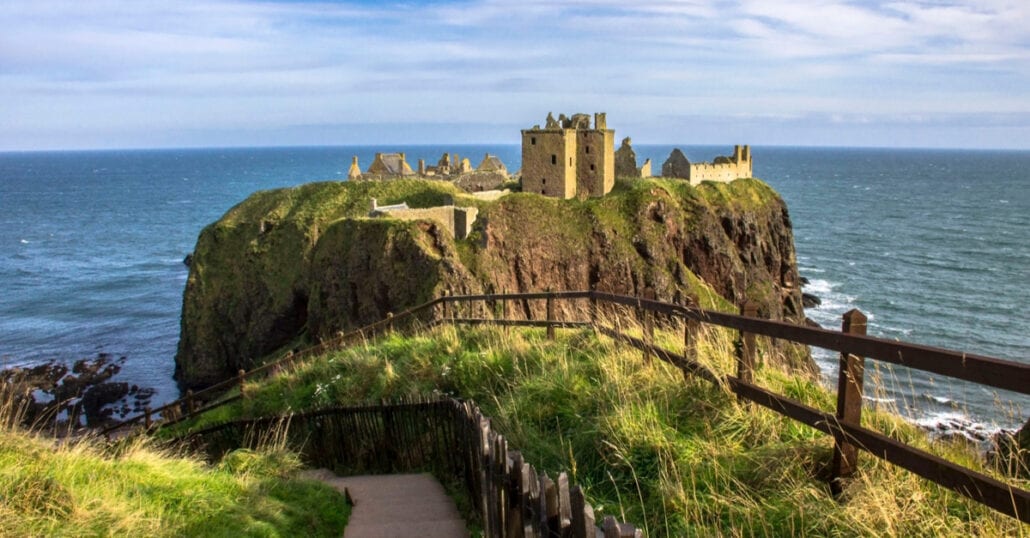
Spread over 1.4 hectares, Dunnottar Castle, Scotland, is located upon a rocky outcrop on the edge of the North Sea.
This castle is a ruined medieval fortress on the northeastern coast of Scotland, and it’s believed to have been fortified in the Early Middle Ages.
With surviving buildings of the 15th and 16th centuries, Dunnottar was the home of the Earls Marischal, one of the most powerful families in Scotland, and it has been visited by illustrious figures like the Mary Queen of Scots and James VI.
Balmoral Castle, Aberdeenshire,
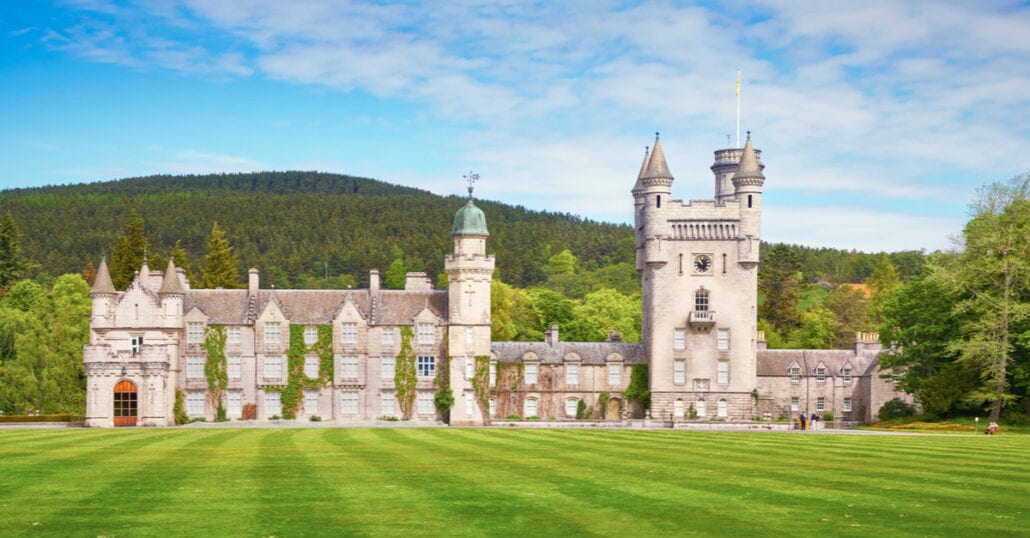
From April to July each year, the Balmoral Castle becomes open to the public. Since 1852, the castle has been the official residence of the British Royal Family in Scotland, and the Queen usually spends the summer on the estate.
Balmoral Castle was built in 1855, and it was designed by Prince Albert and Aberdeen architect William Smith for Queen Victoria.
A fine example of Scottish baronial architecture, the castle includes forestry, farmland, and formal gardens with a number of Victorian glasshouses with potted plants.
The Castle Ballroom, which is the castle’s largest room, is the only one open to the public.
Stirling Castle, Stirling
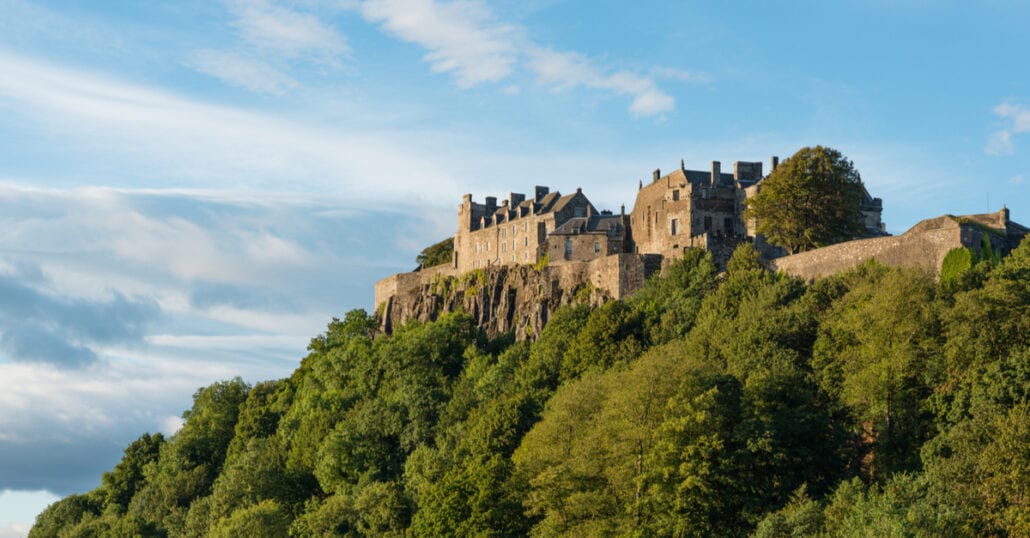
One of Scotland’s greatest castles, the Stirling Castle is placed atop Castle Hill, as during its long history it has been used as a palace as well as a fortress.
With buildings dating back to the 15th and 16th centuries, the Stirling Castle hosted the coronation of several Scottish kings and queens, such as Mary, Queen of Scots, in 1542.
The castle has a Royal Palace, which is one of the best-preserved Renaissance buildings in the UK; a banqueting hall built for James IV in 1503; a Royal Chapel and a garden with 200 years old trees.
Glamis Castle, Angus
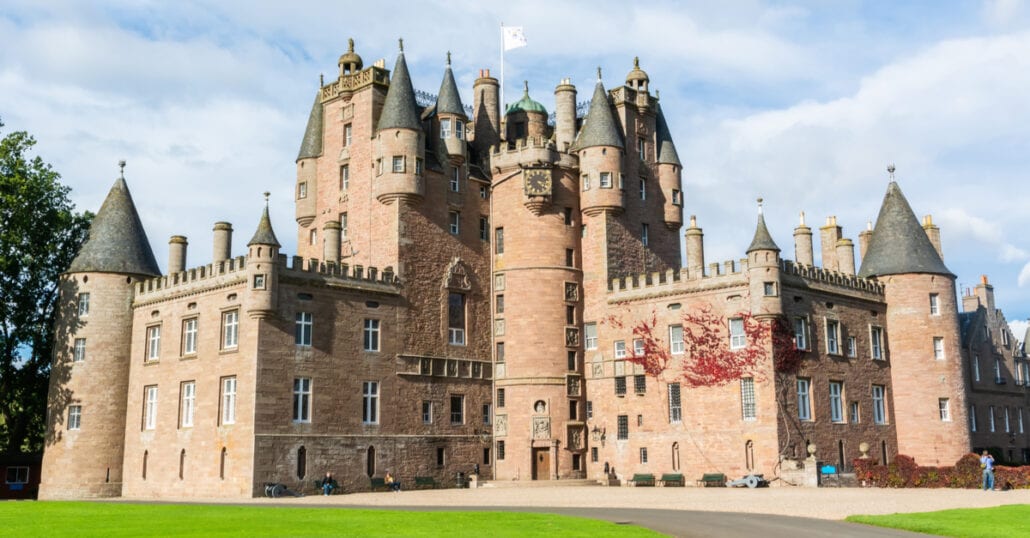
The Glamis Castle is a fascinating place located beside the village of Glamis, in Scotland. Birthplace of Princess Margaret and childhood home of Queen Elizabeth the Queen Mother, the castle also served as inspiration for Shakespeare’s Macbeth, and it has been the family seat of the Strathmore Earls since the 15th century.
The castle consists of royal apartments, a king’s room, a dining room, a crypt, and 4 sumptuous gardens, including one designed by Countess Cecilia, where you can spot squirrels and pheasants.
Castles in Ireland
Kilkenny Castle, Kilkenny
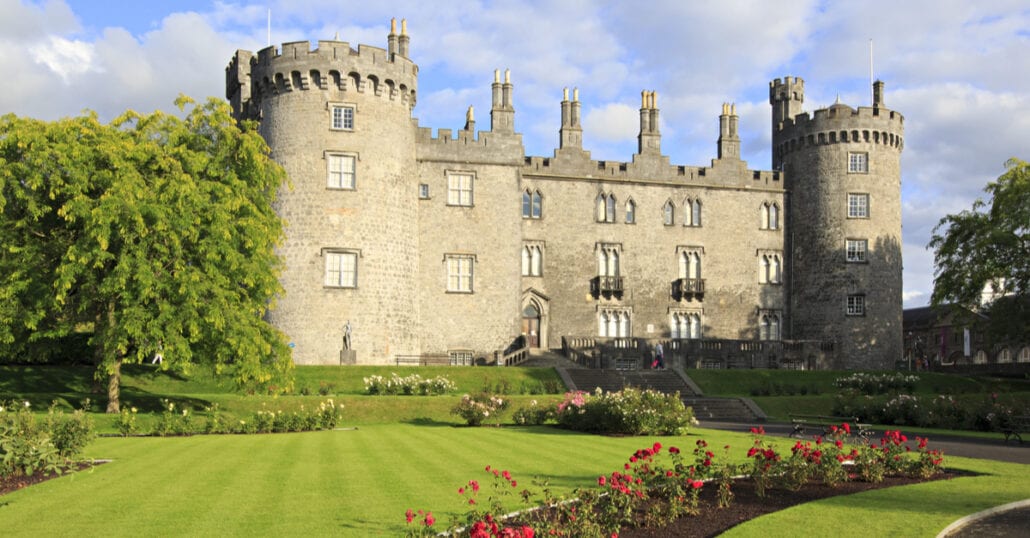
Built in 1195, the Kilkenny Castle was the seat of the powerful Butler family. The fortification was remodeled in Victorian times and has undergone several restoration works over the years.
Nowadays you can explore the castle through a guided tour, which will take you to discover the grand interiors of the castle, with the library, the drawing room, the Victorian Nursery, and the 19th-century Picture Gallery, built to house the Butler’s paintings.
Also make sure to wander around the castle’s extensive parkland, which is home to a rose garden and an ornamental lake.
Castles in Wales
Conwy Castle, Conwy
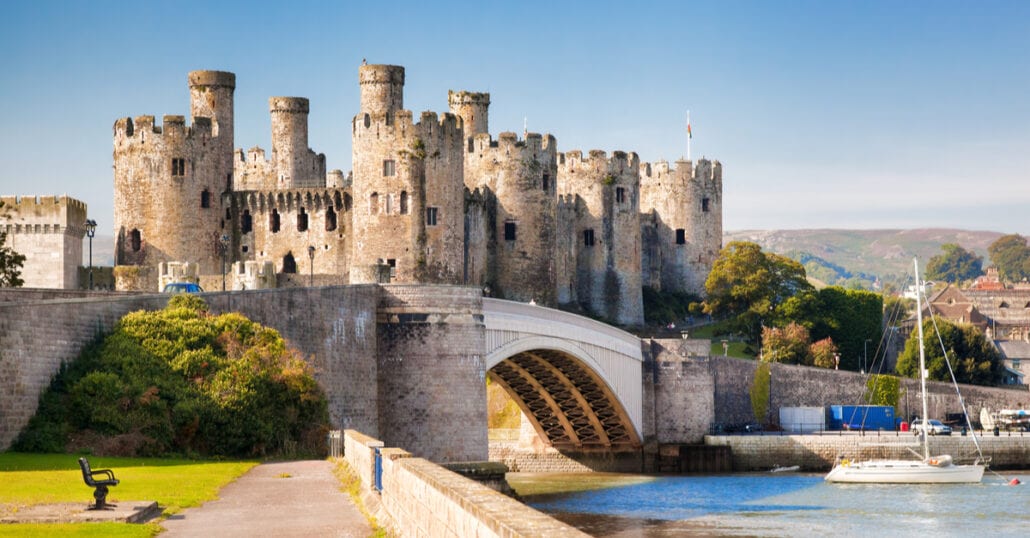
“One of the finest examples of late 13th-century and early 14th-century military architecture in Europe”. This is how UNESCO describes Conwy Castle, Wales.
Erected between 1283 and 1289 by Edward I during his conquest of Wales, the castle is one of the most important surviving medieval fortifications in Britain.
Built from stone on a coastal ridge, it offerers its visitors a looking out across the mountains, the verdant Welsh countryside, and the sea.
The Conwy Castle is divided into an outer and inner ward protected by 21 towers and three gateways. On the internal part of the castle, which houses the most intact set of medieval royal apartments in Wales, you can have a sneak peek of the King’s Apartments, a restored spiral staircase, and the Great Hall.
Caernarfon Castle, Caernarfon
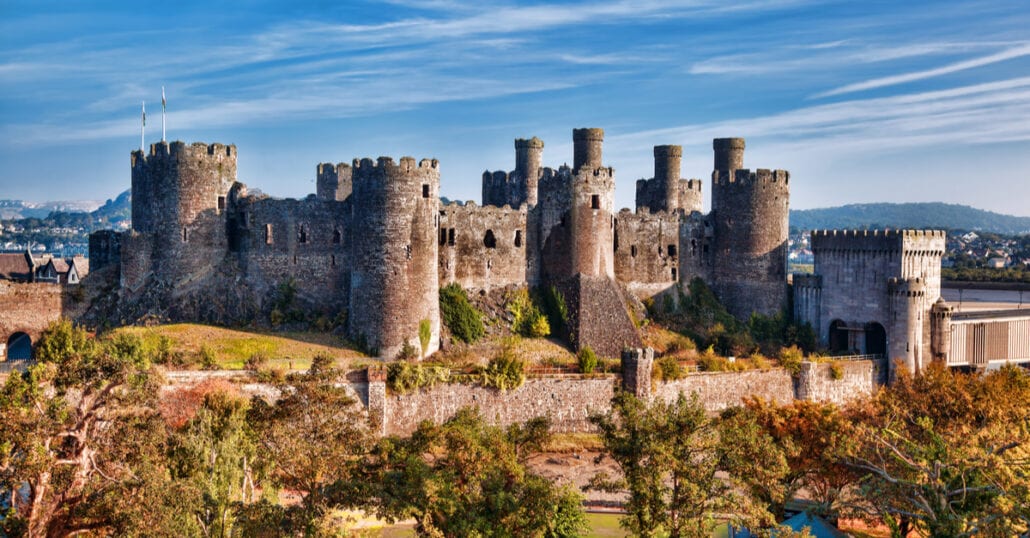
Caernarfon Castle is widely regarded as one of the greatest buildings of the Middle Ages. Situated on the banks of the River Seiont, in north-west Wales, this late 11th-century medieval fortress built by Edward I between 1283 and 1330 boasts impressive architecture.
It has polygonal towers -instead of the traditional round ones- color-coded stones, and eagle statues. And you can see all that by walking through the towers, from the Eagle Tower to the Queen’s Tower filled with medals, uniforms, weapons, and historical displays.
Harlech Castle, Harlech
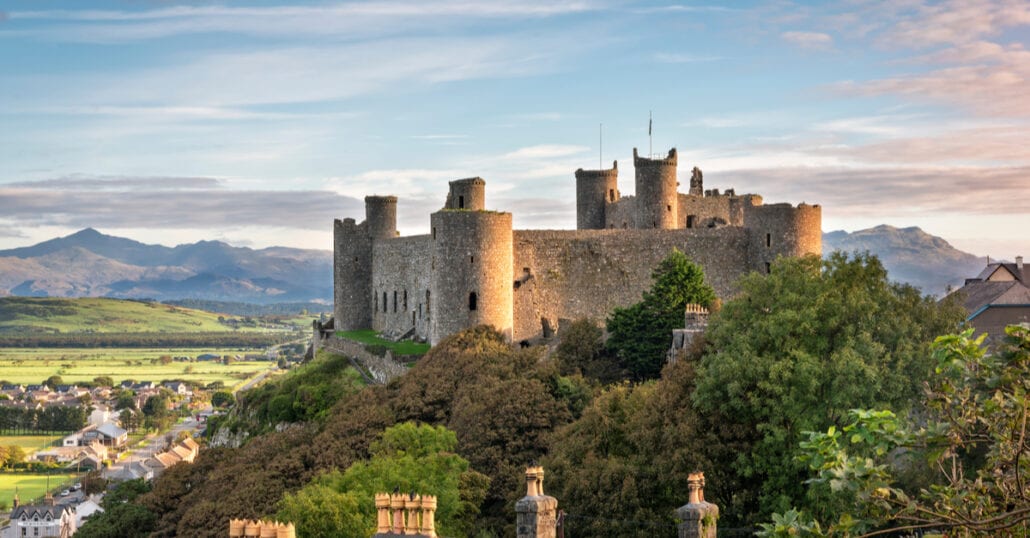
Harlech Castle is a medieval fortification built on a rocky crag by Edward I during his invasion of Wales, being part of the Ion Ring of Castles, a chain of fortifications and castles built in north Wales. A visit to this colossal fortress located close to the Irish Sea is a must for a few reasons.
The first is that it offers jaw-dropping views of a mountainous panorama of the Welsh countryside. Second, the castle was carefully designed by the architect Master James of St. George, who adapted the construction to the site to match the defensive requirements of the age.
Built of local stone, it boasts a concentric design, a double-towered gatehouse, and grand fireplaces on the two upper floors.
Powis Castle, Welshpool
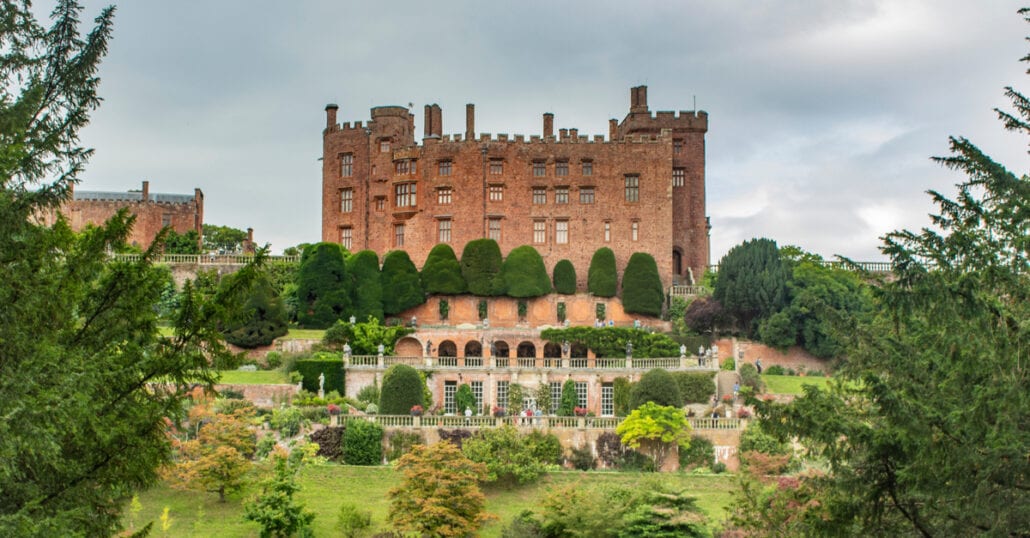
With lush verdant gardens that date back to the 1680s, the Powis Castle was built near Welshpool in the 13th century by Gruffudd ap Gwenwynwyn, a Welsh prince.
Also known as Castell Coch (Red Castle), it used to be the residence of the Lords of Powis until 1421 and, over the decades, it has been rebuilt until it was transformed into a mansion.
When visiting Powis Castle, you’ll be amazed by its extensive parkland and ornate garden designed by the architect William Winde.
Inside, you can admire the luxurious rooms that were remodeled and modernized by George Herbert, the 4th Earl of Powis, who inherited the property.
Thanks to him, many of the staterooms such as the State Dining Room, the Oak Drawing Room, and the Duke’s Room display a 17th-century décor.
His wife, Lady Violet, was in charge of improving the garden, which she worked on for over 18 years. Considered a true “paradise in Wales”, the garden has a dramatic Italianate terrace, an Orangery with an 18th-century stone doorway, 100-year-old apple trees, great oaks, and rhododendrons.
Cardiff Castle, Cardiff
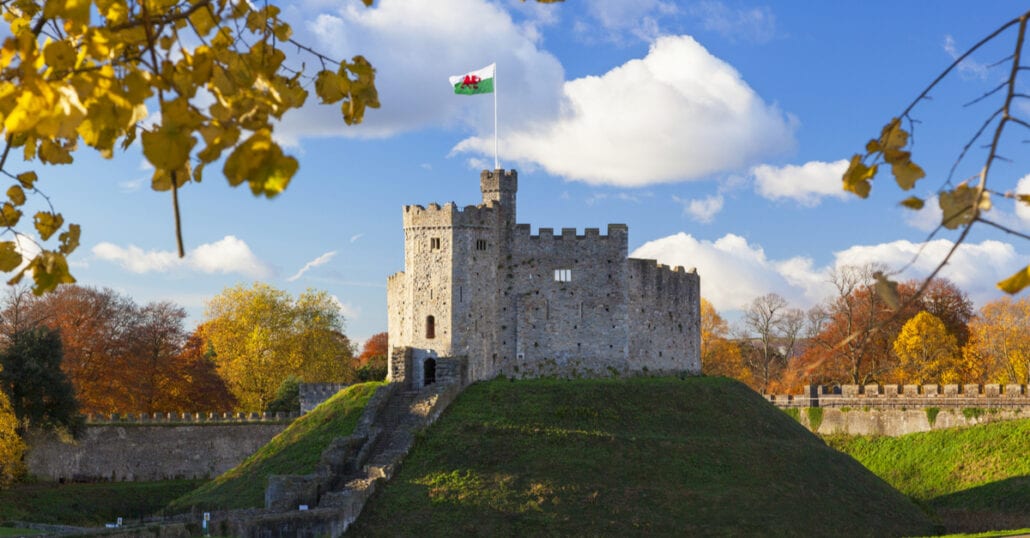
Cardiff Castle is one of the most important heritage attractions in Wales. Located in the heart of Cardiff, the Castle was occupied by many noble families until in 1766 it passed by marriage to the Bute family.
To learn more about the castle’s history, pick up a portable audio guide and delve into the fortification’s opulent interiors, designed by the brilliant architect William Burges.
Each room has its unique features, like murals, wooden ornaments, marble pieces, Mediterranean gardens, and Italian and Arabian decorations.
Chepstow Castle, Chepstow
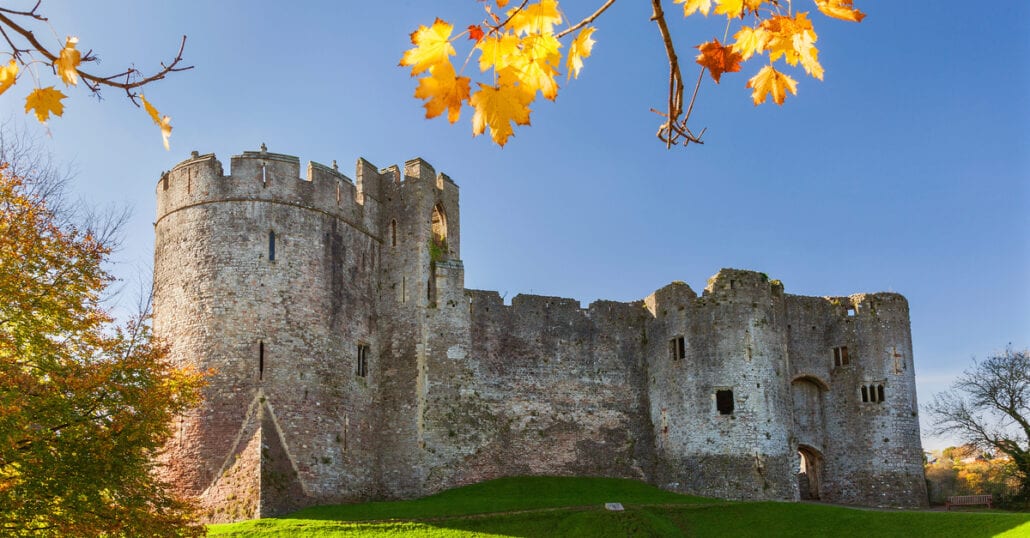
Located above the cliffs on the River Wye, at Chepstow, the Chepstow Castle (Castell Cas-Gwent) is the oldest surviving post-Roman stone fortification in Britain.
Its construction began in 1067 by Earl William Fitz Osbern, which was a friend of William the Conqueror, it was home to some of the most affluent men of the Medieval and Tudor ages.
Cas-Gwent was fortified and rebuilt in the 12th century, but later in the 14th, its defensive importance was lowered. It became a popular attraction in Wales, as it has plenty of towers and green spaces.
Castles in Switzwerland
Chillon Castle, Veytaux
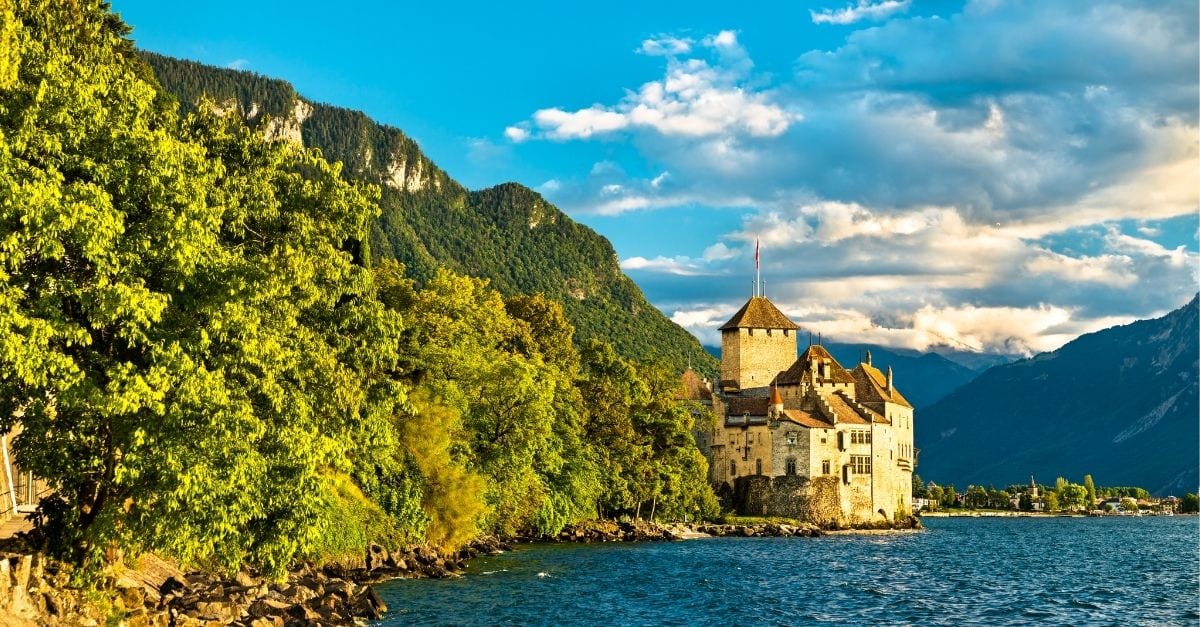
The Chillon Castle does not receive more than 400,000 guests per year by chance. This fairytale monument is placed on the shores of Lake Geneva and is molded with the same oval shape of the rocky island upon which it was built.
Considered a waterside castle, Chillon is a floating gem that offers visitors an immersive experience. The castle was marked by three great periods, the Savoy (12th century to 1536), the Bernese (1536 to 1798), and the Vaudois (from 1798 to today), and during your visit, you can learn about each one of these eras.
Chillon has 25 buildings, three courtyards, paintings from the 14th century, subterranean vaults, and around 300 items on display, which were found during archaeological excavations from 1896 to 1903.
Castles in Denmark
Kronborg Castle, Helsingor
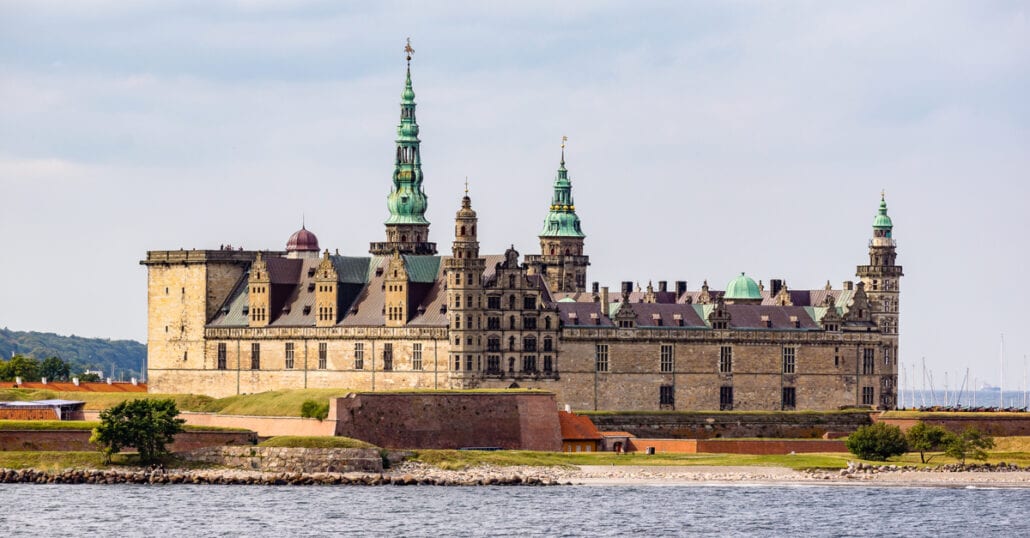
When traveling to Copenhagen, make sure to take some time to visit the Kronborg Castle, Denmark, which is located in the village of Helsingør, less than an hour north of the city.
The Kronborg Castle was built in the 1420s as a stronghold, and then later enlarged by the Danish king Frederik II, who transformed it into a Renaissance castle in 1585.
Part of the castle was destroyed during a fire in 1629, but many rooms were renovated by King Christian. During your visit, you’ll certainly be mesmerized by its rooms, tapestries, royal apartments, a 1582 chapel, and more.
This stunning castle is the setting of Shakespeare’s play ‘Hamlet’, and one of the most important Renaissance castles in Europe. There are even some rumors that say that Shakespeare himself could have been in the castle!
Frederiksborg Castle, Hillerød
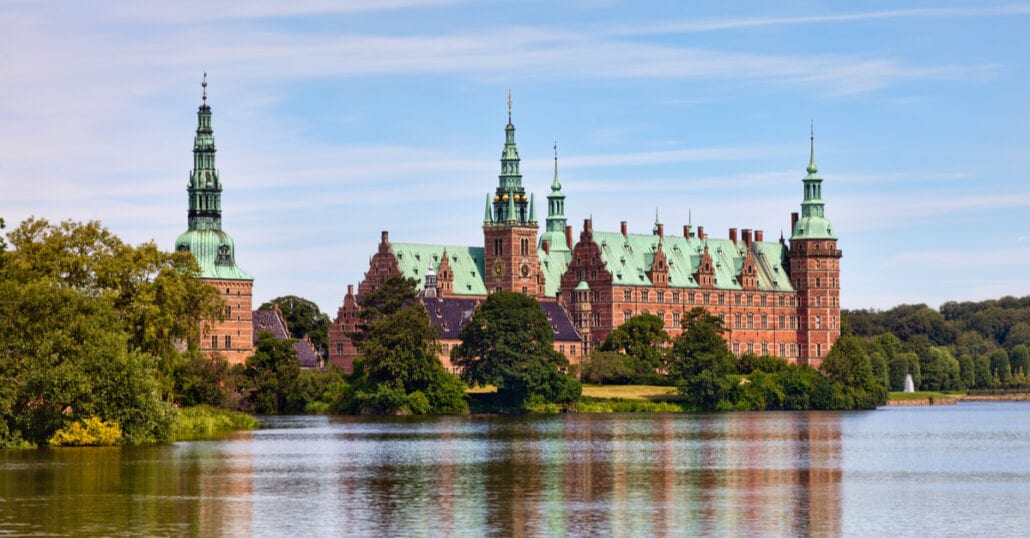
Undoubtedly one of the most beautiful castles in Europe, the Frederiksborg Castle, Denmark, is a palatial complex built as the royal residence for King Christian IV in the 17th century.
Located in Hillerød, the castle displays ornamented symbolic and decorative elements, like the Neptune Fountain and the Marble Gallery of the King’s Wing.
One of the most impressive features of the Frederiksborg castle is the Chapel, with a gold, silver, and ebony altarpiece crafted by a Hamburg goldsmith in 1606 and a historic Compenius organ, built in 1610 by Esajas Compenius.
Castles in Slovakia
Spiš Castle, Žehra
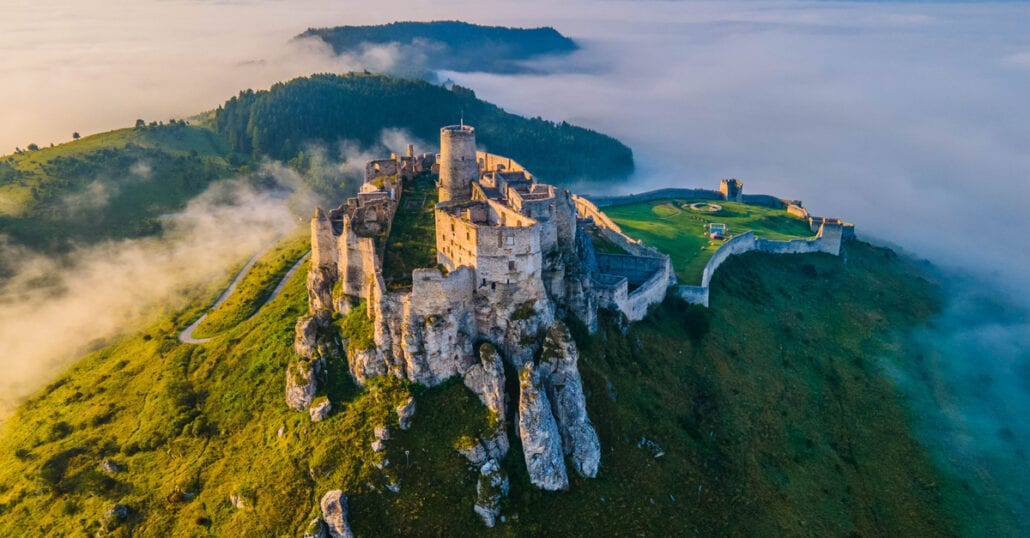
What used to be a castle that hosted balls for the upper class and a prestigious courtly life is now ruins spread above the town of Spišské Podhradie, in Slovakia.
A Unesco-listed fortification the Spis Castle is one of the biggest European castles by area (41,426 m²) that rises above the sea level of 634 meters.
A visit to the Spis Castle will take to uncover the archaeological part of the monument. There, you can see findings from the Stone Age until the Middle Ages, stonewalls from the 18th century, and a tower with a view of the province, which is filled with, Romanesque churches, and gothic houses. Also make sure to visit the Museum of medieval history, which is within the former palace.
Orava Castle, Oravský Podzámok
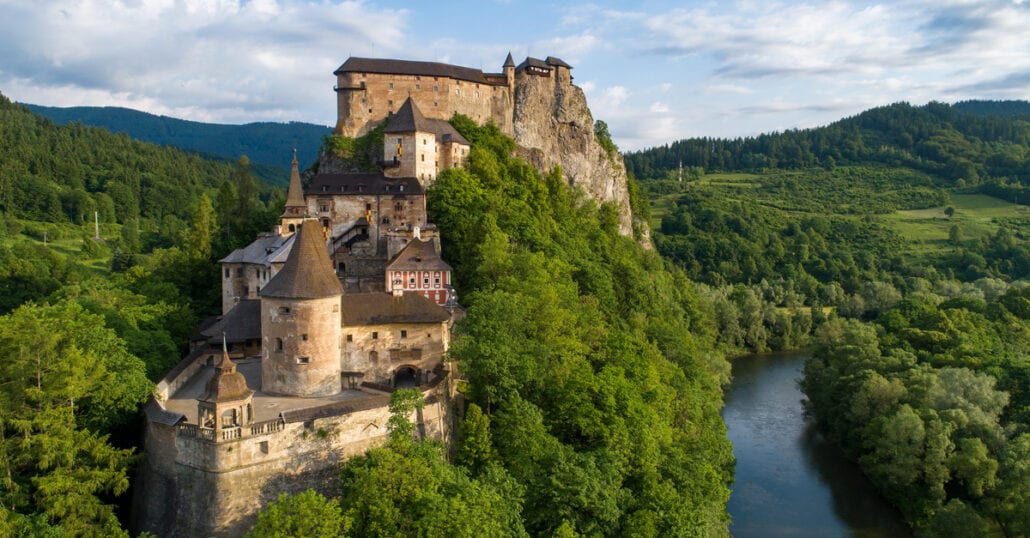
Did you know that, aside from being one of the most beautiful castles in Slovakia, the Orava Castle was also the set of the 1922’s movie Nosferatu?
Built-in the 13th century after the Mongol invasion, this vampiresque fortification is placed on a high rock above the Orava River. It served as the residence of people such as György Thurzó, a powerful Hungarian magnate who was the judge who sentenced Countess Elizabeth Báthory, a vicious killer who has been named by Guinness World Records as the most prolific female murderer.
Outlasted over the centuries thanks to its 5m-thick walls, the Orava Castle displays different architectural styles, such as the Romanesque, Gothic, and Renaissance.
The tour will take you to uncover the castle’s chambers, filled with sumptuous furniture and weaponry, the knight’s room, a paintings gallery, and a collection of archaeological artifacts.
Castles in the Czech Republic
State Castle Český Krumlov, Český Krumlov
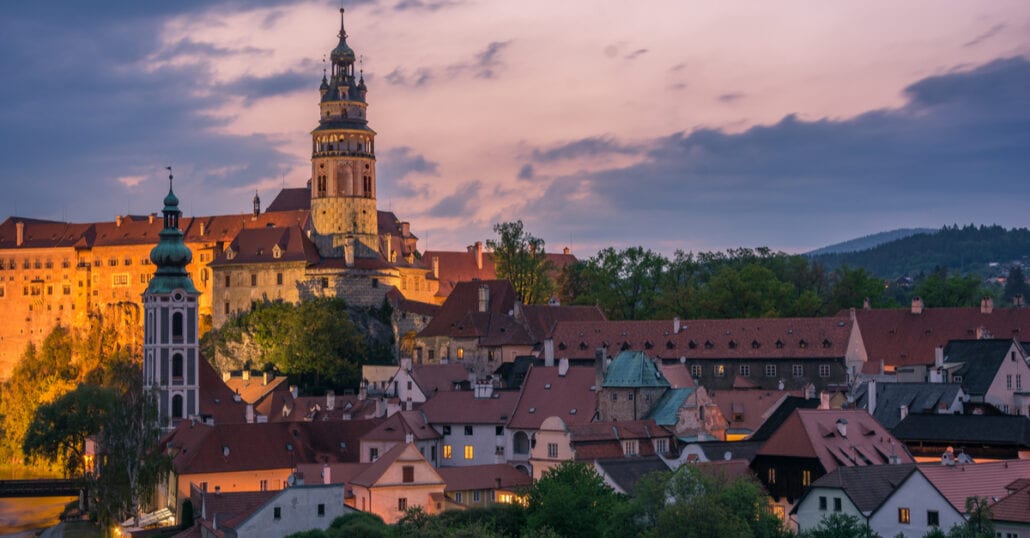
More than 300.000 visitors a year explore this castle’s historical interiors that date back to the 16th, 18th, and 19th centuries. Located in the city of Český Krumlov, in the Czech Republic, the Český Krumlov Castle sits on a rocky headland and it was included in the list of UNESCO World Cultural Heritage Monuments in 1992.
The original castle was founded in the Czech Republic by the Lords of Krumlov in the 1200s and then the Bohemian family Rosenberg inherited it in 1302. It’s a large complex of forty Renaissance and Baroque buildings and palaces surrounded by a forest.
Since it’s a large castle, a guided tour might be a great way to explore it. Just make sure to visit the Baroque Theatre, which is the most important monument of the castle, and it’s one of the most preserved Baroque theatres in Europe.
Castles in Sweden
Gripsholm Castle, Mariefred
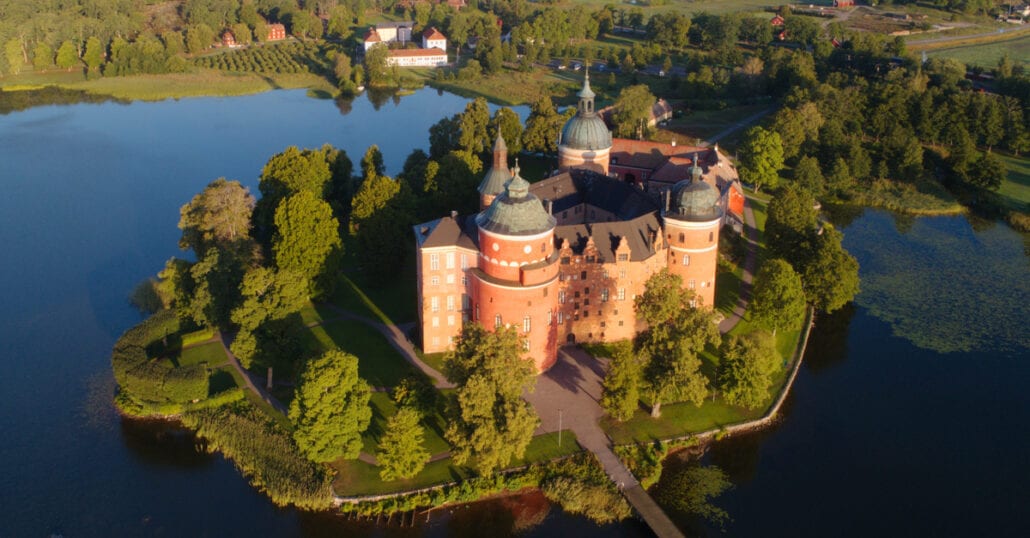
The picturesque town lake of Mariefred, in south-central Sweden, is home to the Gripsholm Castle. Erected in 1537 and boasting an irresistibly romantic atmosphere, this Renaissance palace was part of a system of national defenses in Sweden and was also built as a fitting residence for Gustav Vasa, who was King of Sweden from 1523 until his death in 1560.
Gripsholm Castle, Sweden, belonged to the Swedish Royal Family until the 18th century. Now it’s a museum and a palace at the disposal of the King.
Gripsholm houses a collection of furniture and artwork, which you can uncover while wandering around through its sumptuous rooms like the Hall of State, the Green Salon, and King Gustav III’s Round Salon.
Another highlight is that Gripsholm Castle houses the world’s oldest national portrait gallery, including approximately 5,000 works of art, mostly oil paintings.
Castles in Belarus
Niasviž Castle, Niasviž
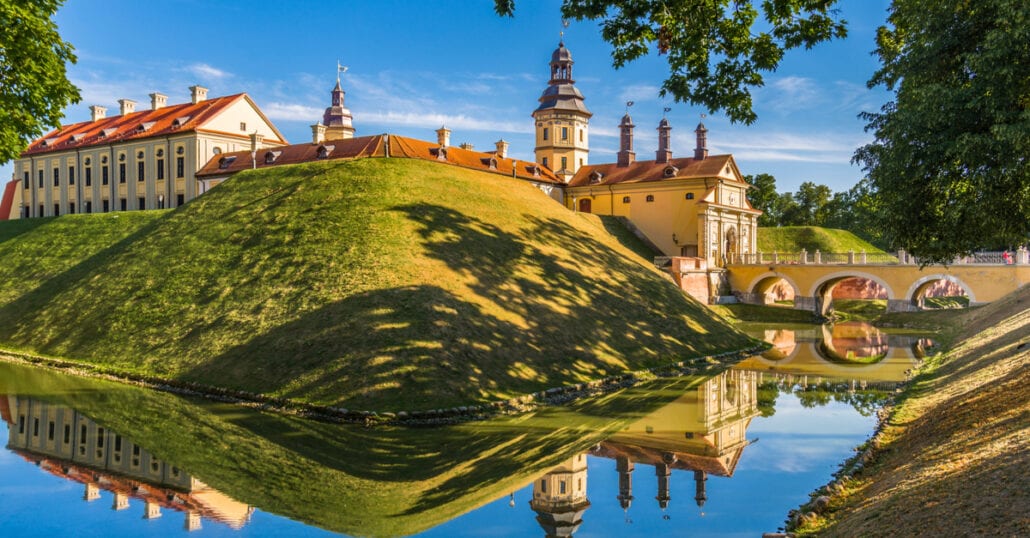
The history of the Nesvizh Castle started in 1582 when the Radziwiłł family started building a powerful fortress in the small town of Nesvizh.
Located 183 meters above sea level and surrounded by water, the castle became one of the best fortresses in the Great Duchy of Lithuania and it’s considered the most beautiful palace in Belarus.
Because it was rebuilt several times, the fortification displays a range of architectural styles, such as Renaissance, Baroque, Rococo, and Neo-Gothic. Home to an extensive garden with ornamental lakes, the castle attracts many visitors each year.
During your visit, take some time to wander around the city of Nieśwież and visit the Corpus Christi Church, which contains the coffins of 72 members of the Radziwiłł family.
Castles in Italy
Miramare Castle, Gargano
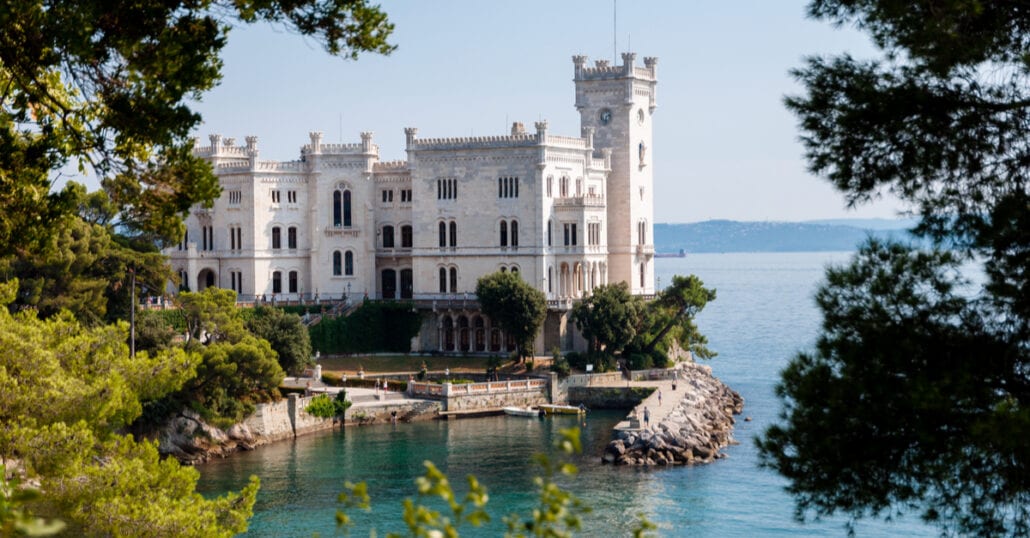
Rising above the promontory of Gargano, overlooking the Gulf of Trieste, the Miramare Castle was built in the 19th century for the Austrian Archduke Maximilian, who lived there with his wife Carlotta until he was brutally assassinated in Mexico.
In fact, legend says that the castle is cursed, and whoever spends the night there will die prematurely in a foreign land, just like the Archduke.
But despite the course, the castle is a true Italian fairy tale. Made up of over 20 rooms -some decorated in German and Turkish style- and influenced by the Romantic aesthetic, the Miramare has a lush verdant park of 22 hectares which was re-landscaped.
Today, the castle showcases a range of tropical botanical species from California, Mexico, Asia, and more.
Sforza Castle, Milan
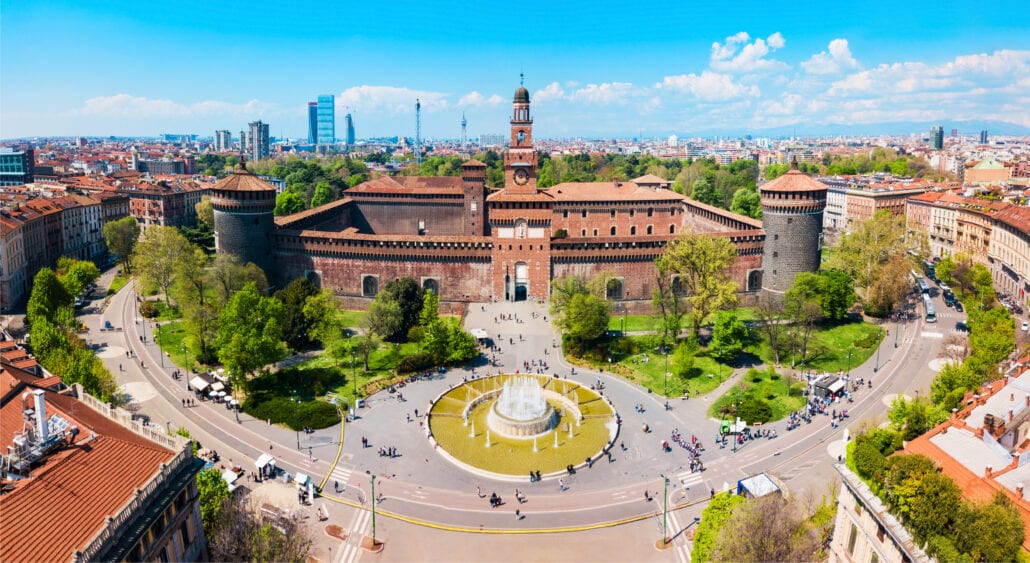
Originally a Visconti fortress, the Sforza Castle was constructed in the 15th century by Francesco Sforza on the remnants of a 14th-century fortification.
The castle was enlarged later on and, in the 16th and 17th centuries, it became one of the largest citadels in Europe. It is set amidst a square and it houses many of Milan’s museums and art collections. You’ll see Michelangelo’s Pietà Rondanini and the Sala delle Asse, which displays frescoes designed by Leonardo da Vinci.
Castelvecchio, Verona
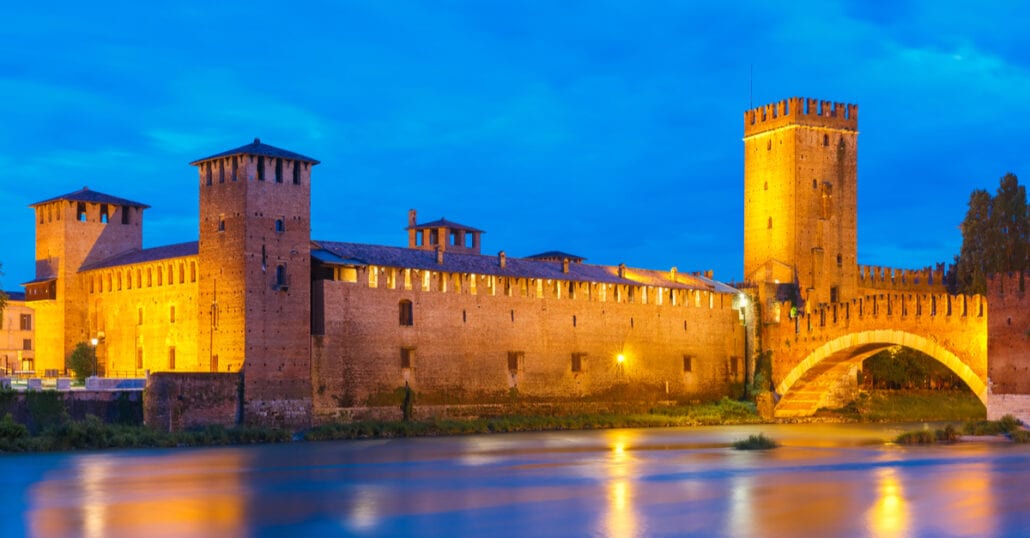
Erected in the medieval city of Verona, in Northern Italy, the Castelvecchio is a large square compound, compact in its size and with very few ornaments.
A prominent example of Gothic architecture, the fortification was built by Cangrande II of the Della Scala family in 1354–1356, on the location that it’s believed to be an earlier Roman fortress.
Castelvecchio is now home to the Castelvecchio Museum, which houses a collection of frescoes, jewelry, medieval artifacts, ancient weapons, and works by Tintoretto, Veronese, Andrea Mantegna, and Pisanello.
Now that you have discovered the top castles in Europe, it’s time to plan your stay. Find the best hotels and vacation rentals on CuddlyNest to stay at while you explore Europe’s most magical and historic castle monuments.




Browse. Book. Stay.
CuddlyNest provides all accommodations to all travelers at the best price. Find unlimited travel inspiration on our blog and social media channels.
You might also like:
Europe’s Offbeat Vacation Destinations
Free Things to do in Barcelona
Fun Facts About Croatia
Here are some curated readings for you:
Fun Facts About Croatia
Best Travel Podcasts
Virtual Tours to Take from Home in Covid Times
Useful Links:
CuddlyNest Blog
Things to do (Destination Deep-Dive)
Activities & Adventure
Food to eat (Cuisine Crawl)
Where to Stay
Hacks & Tips
